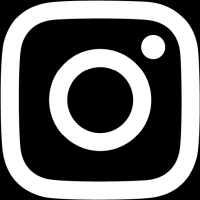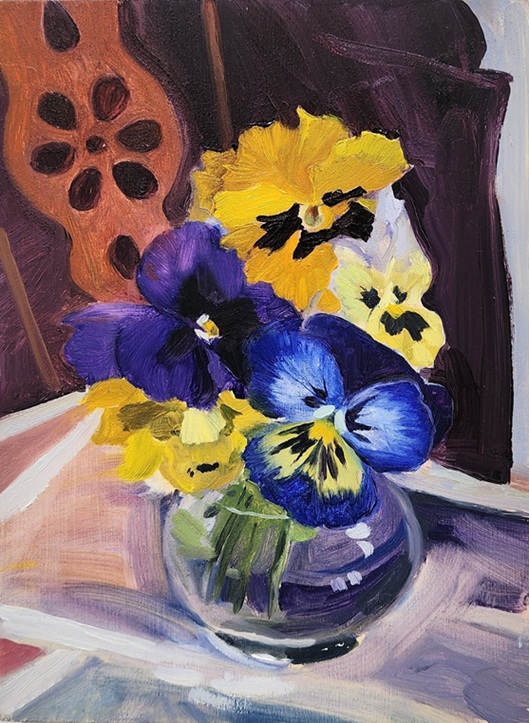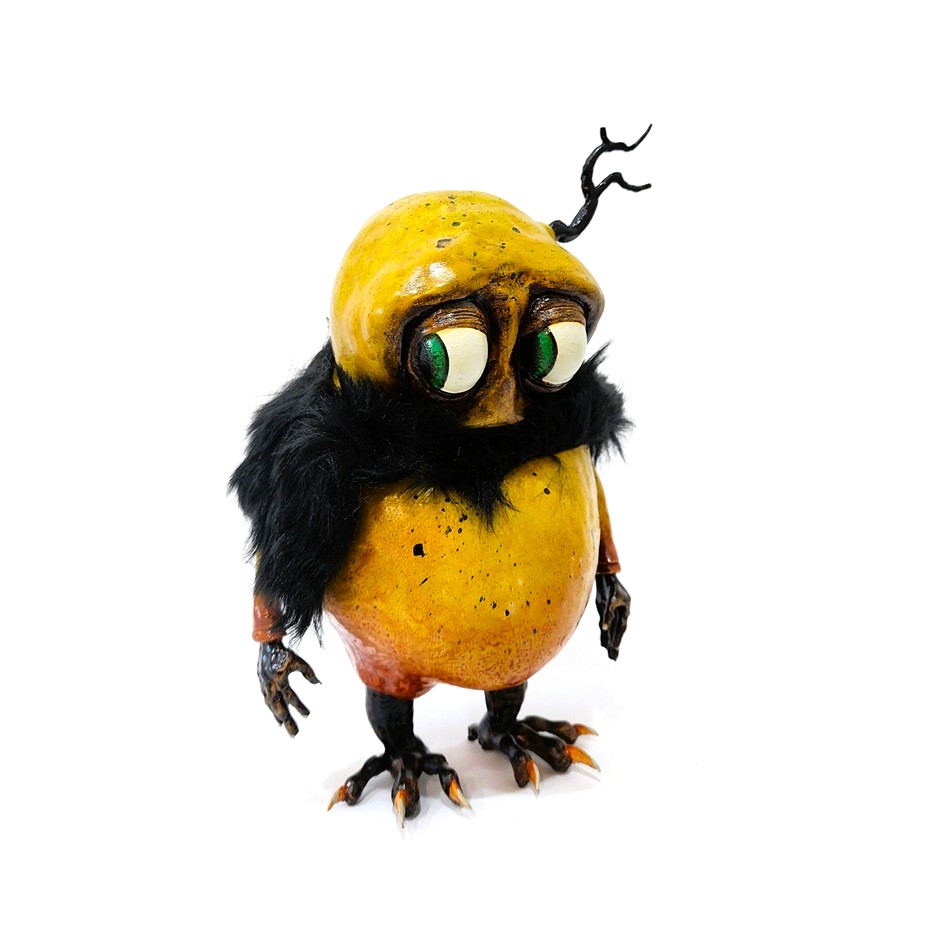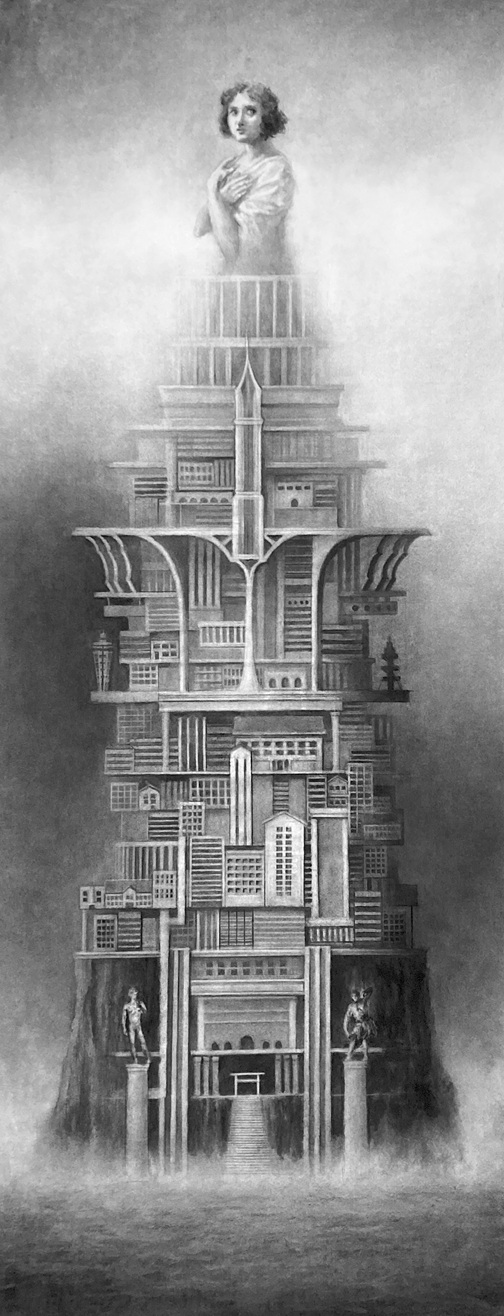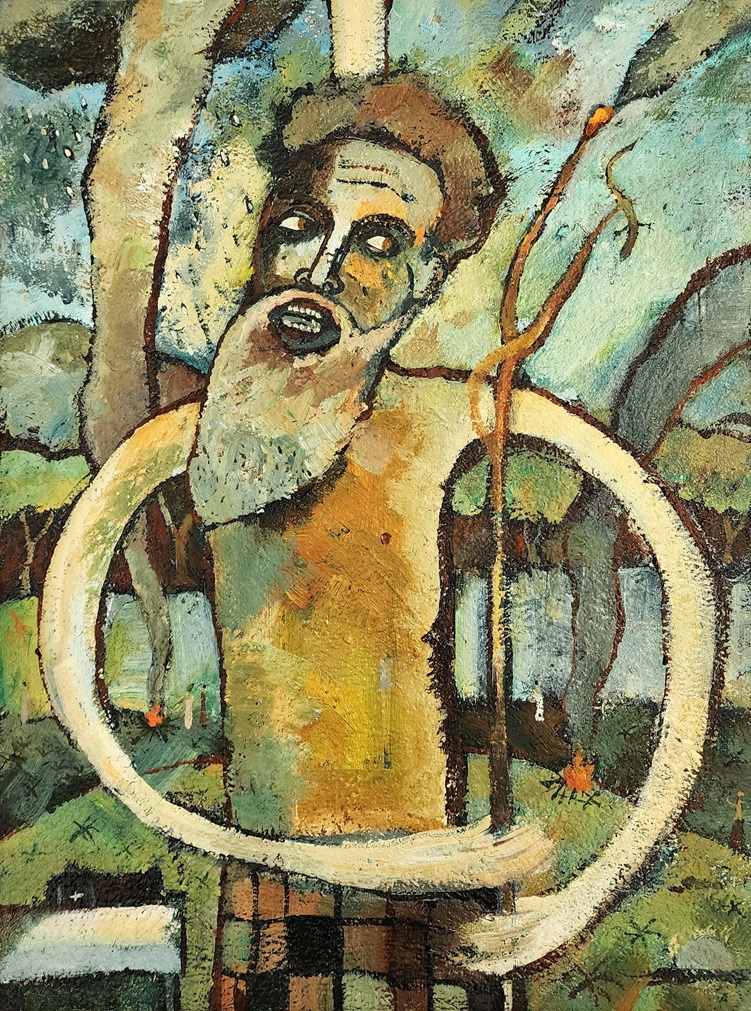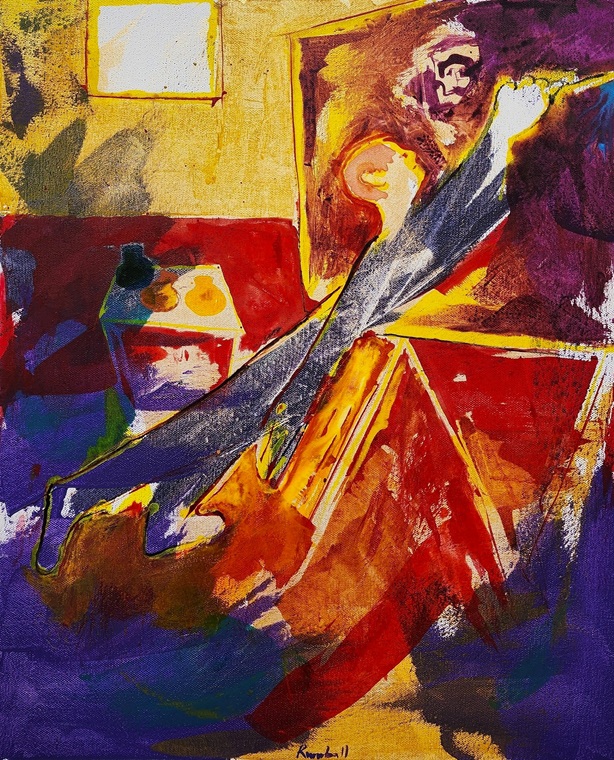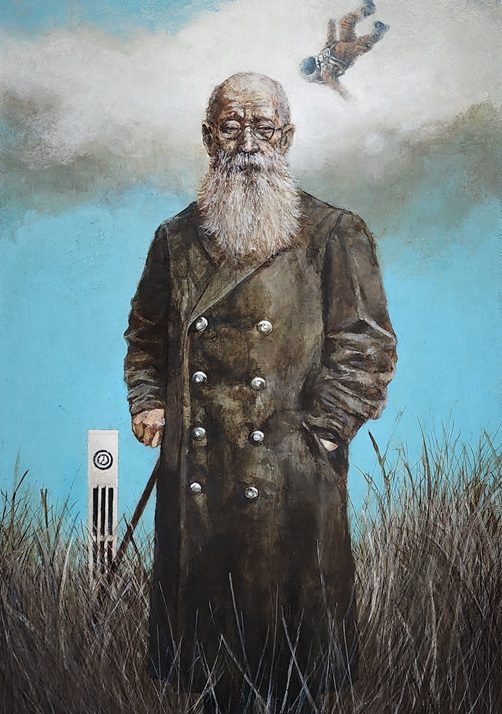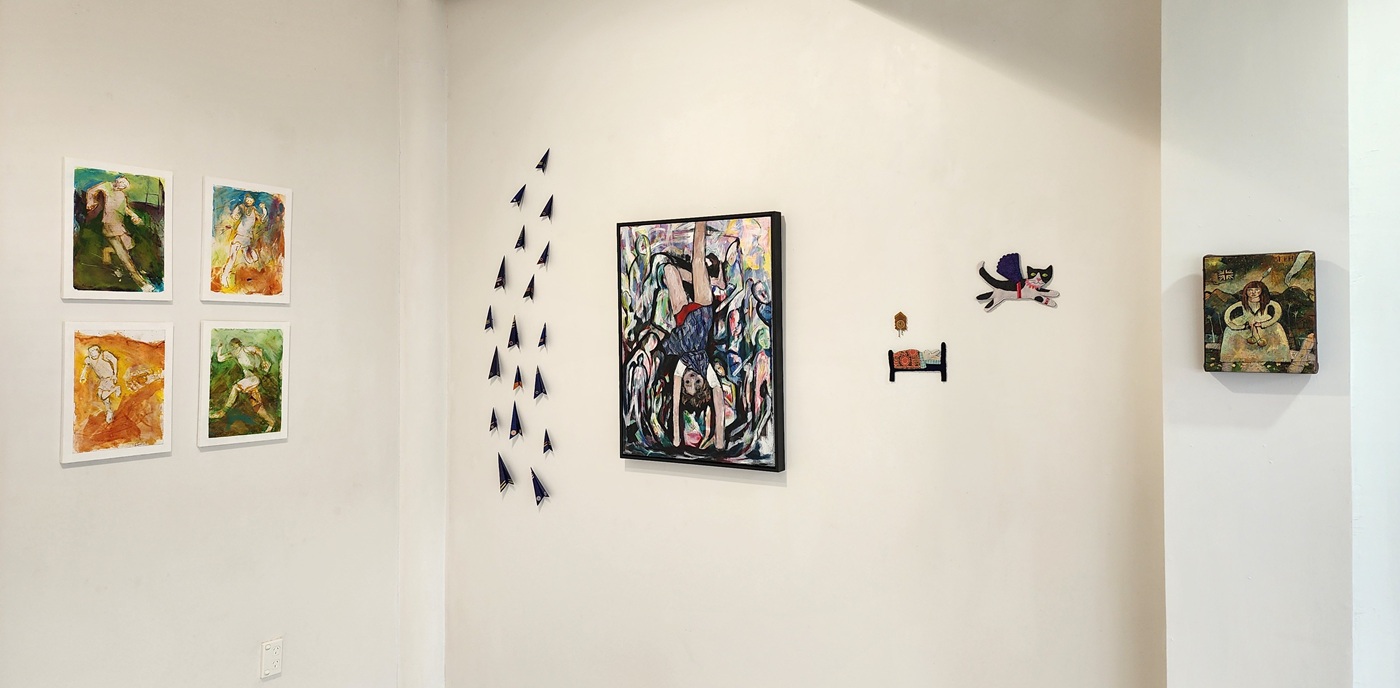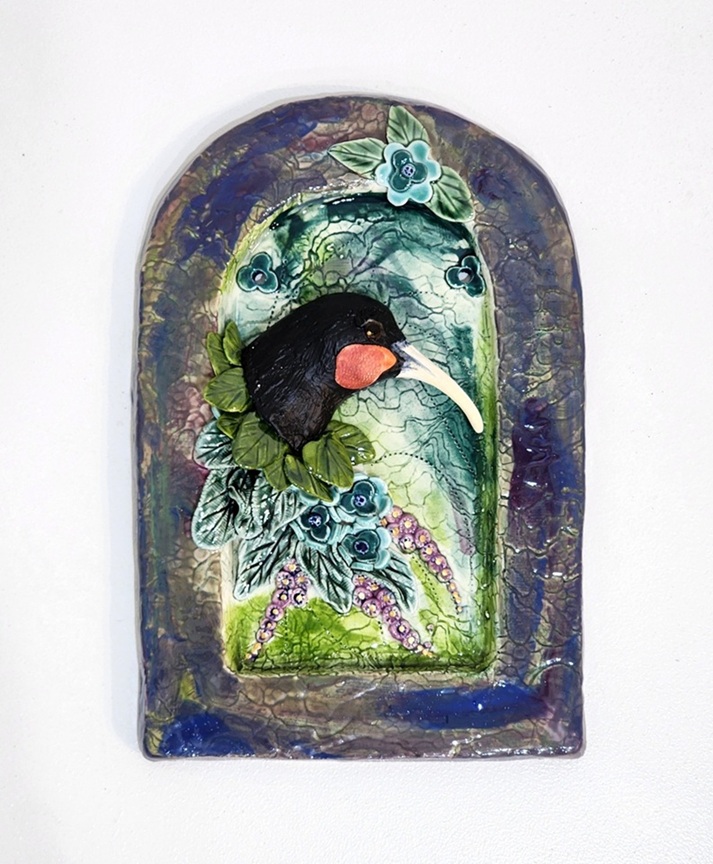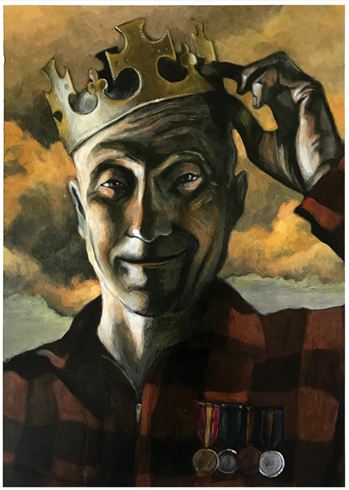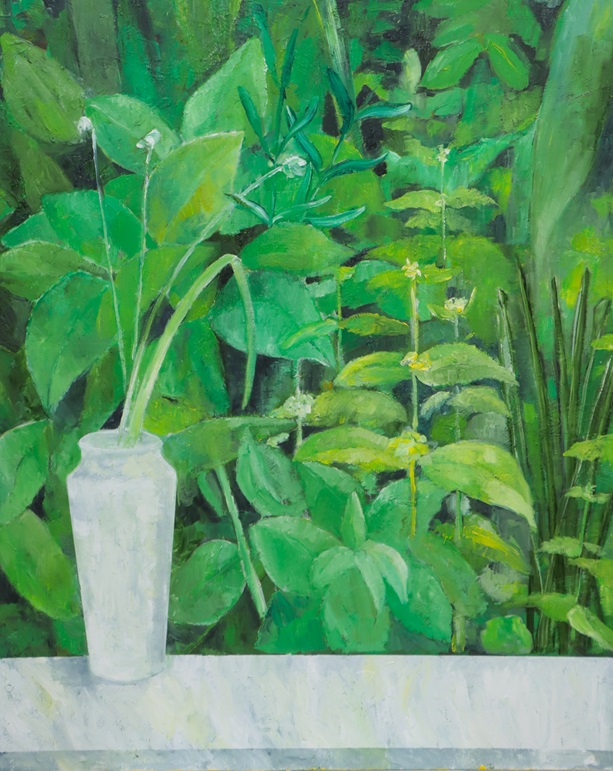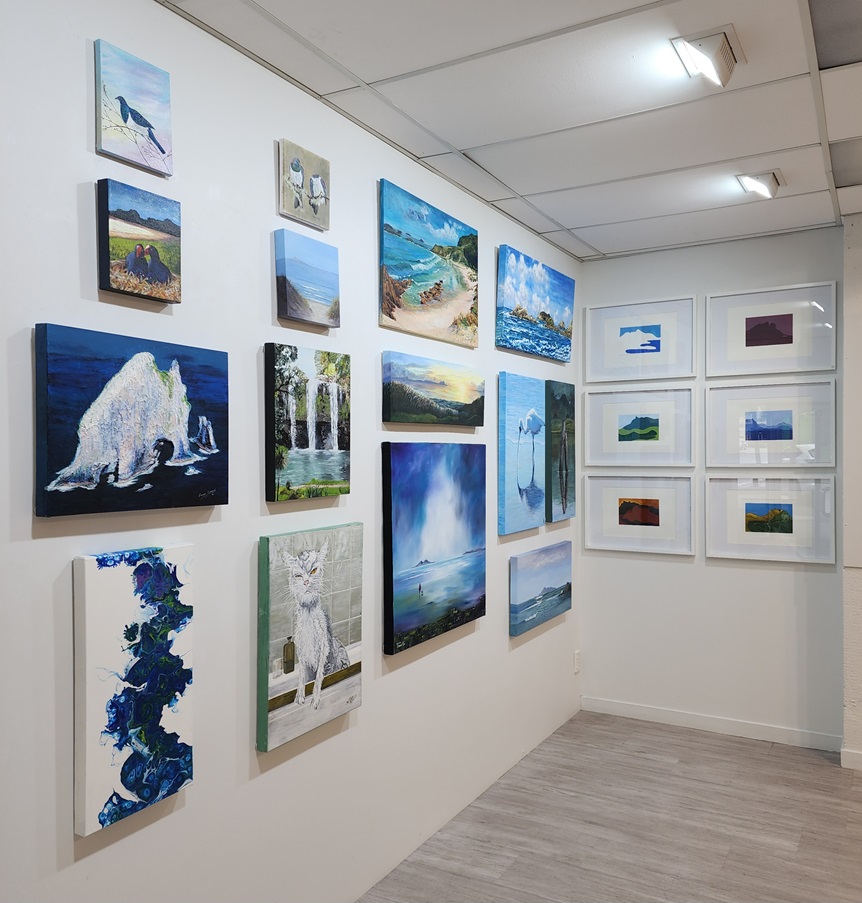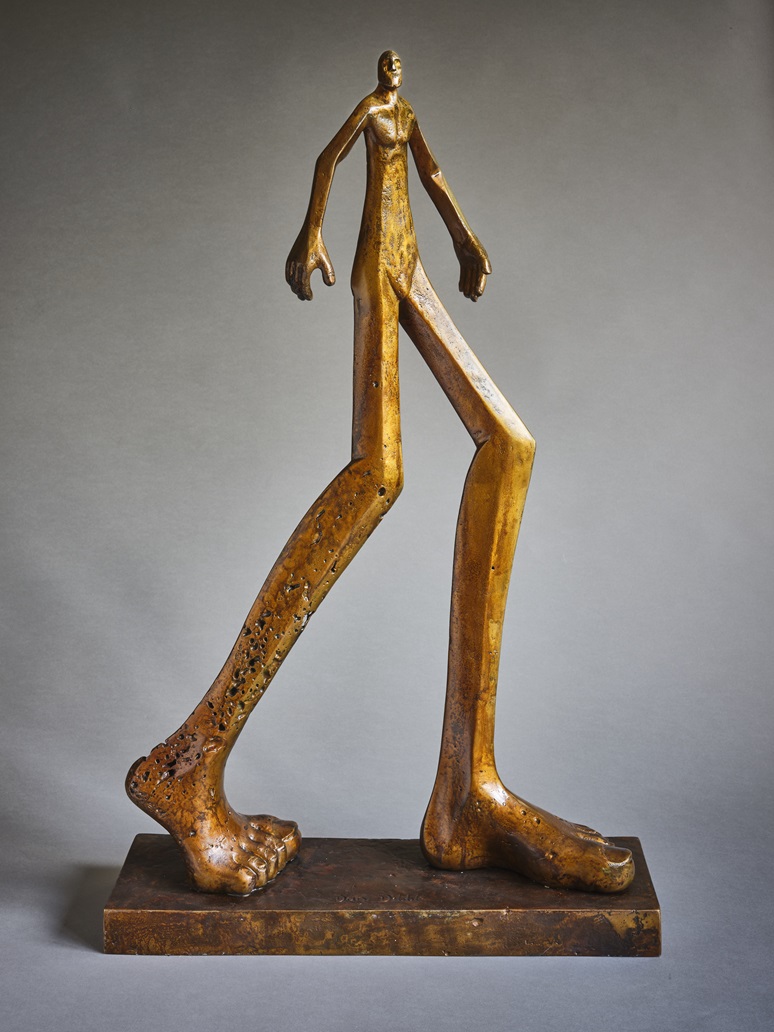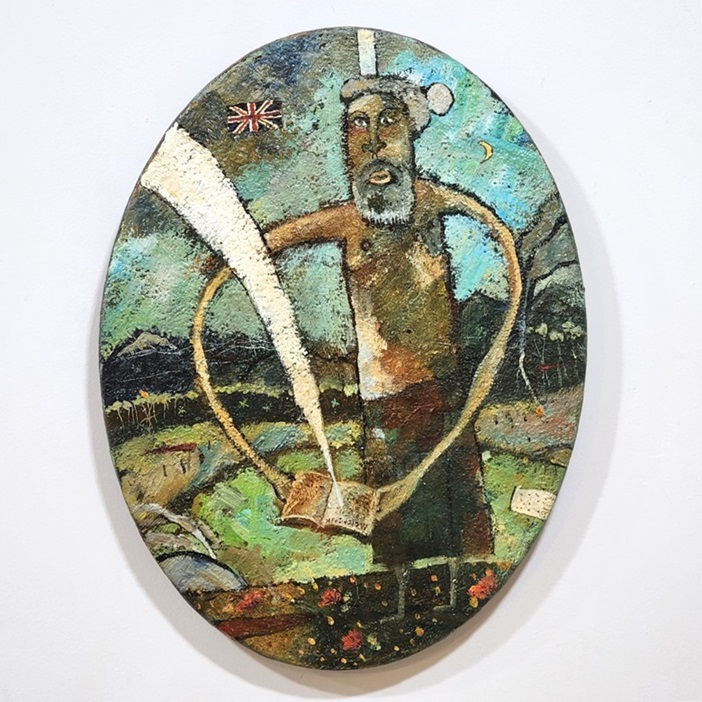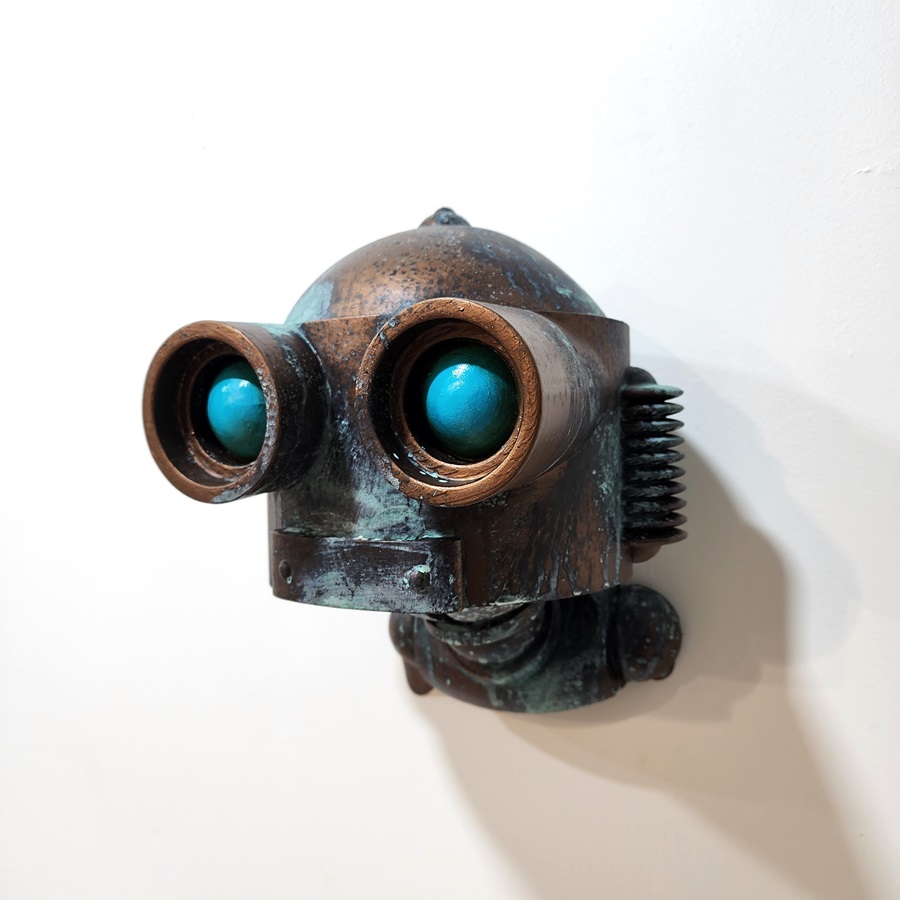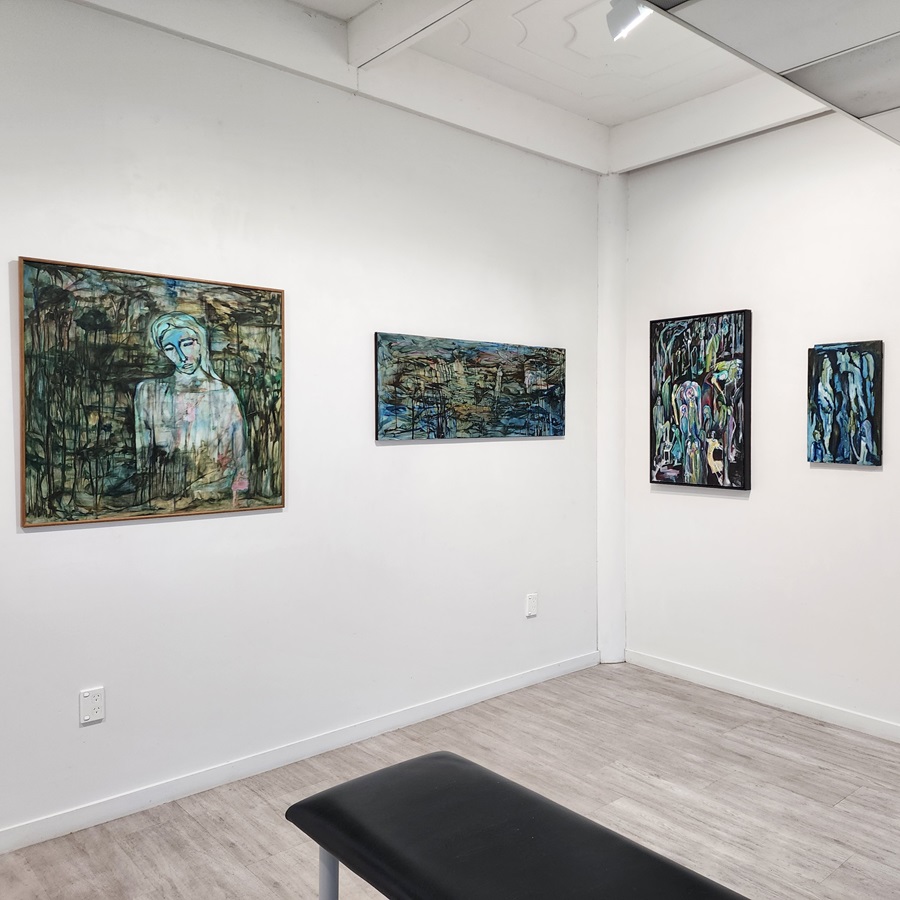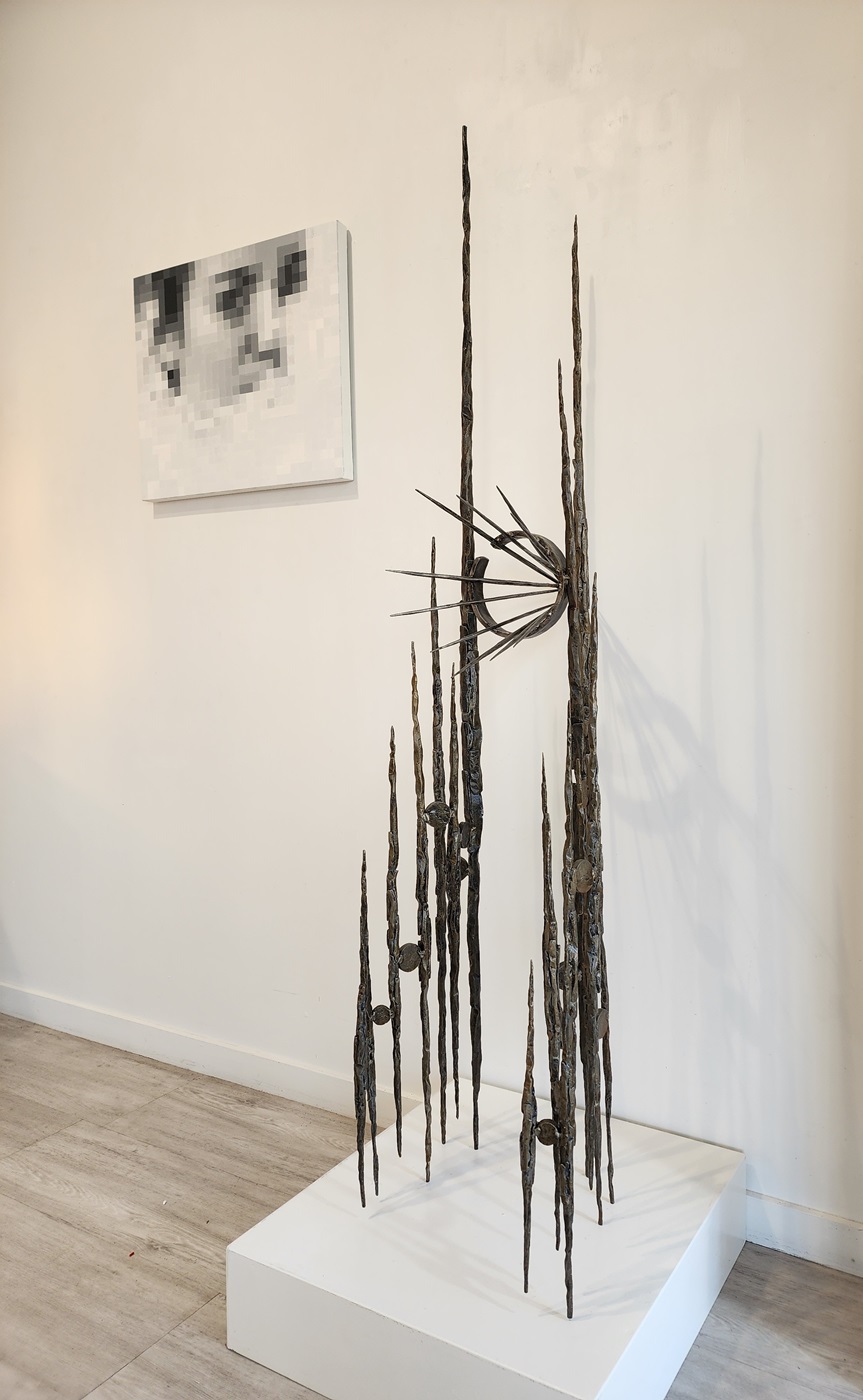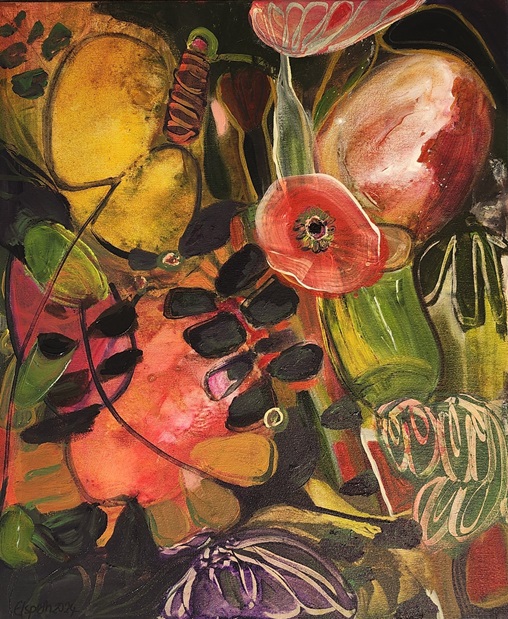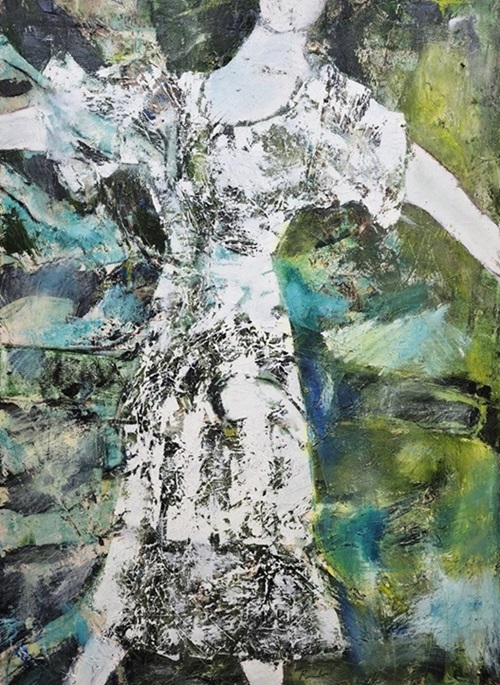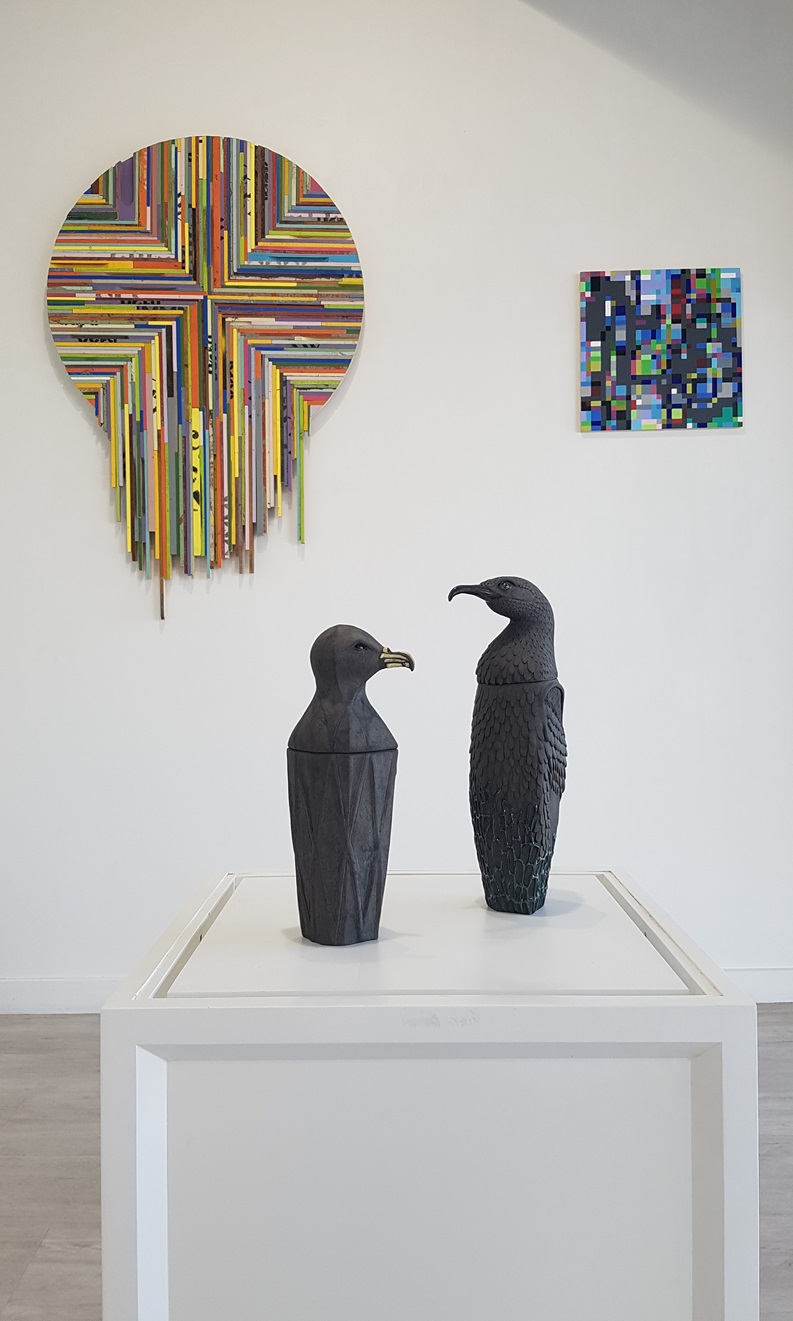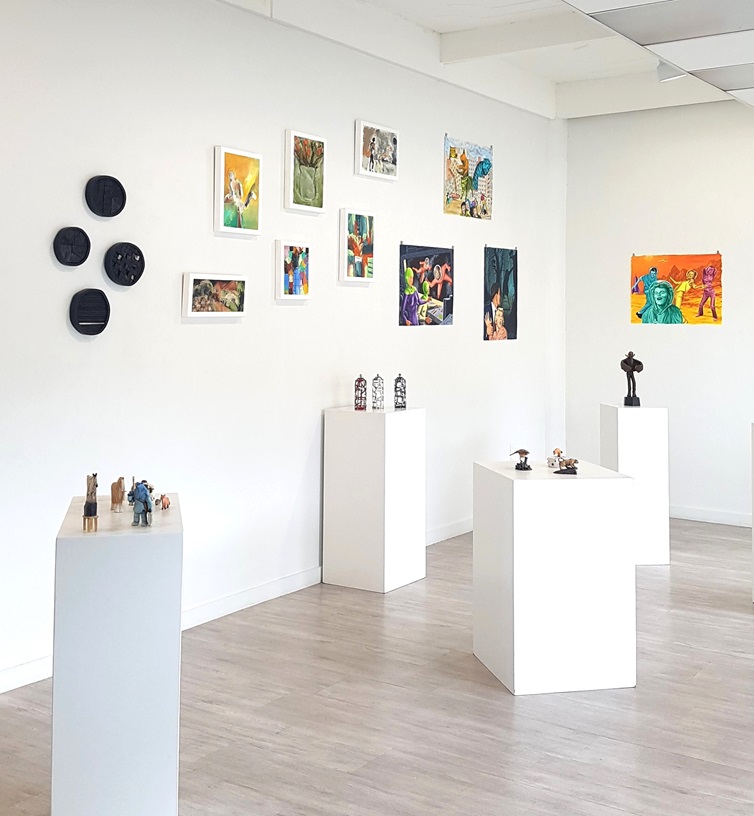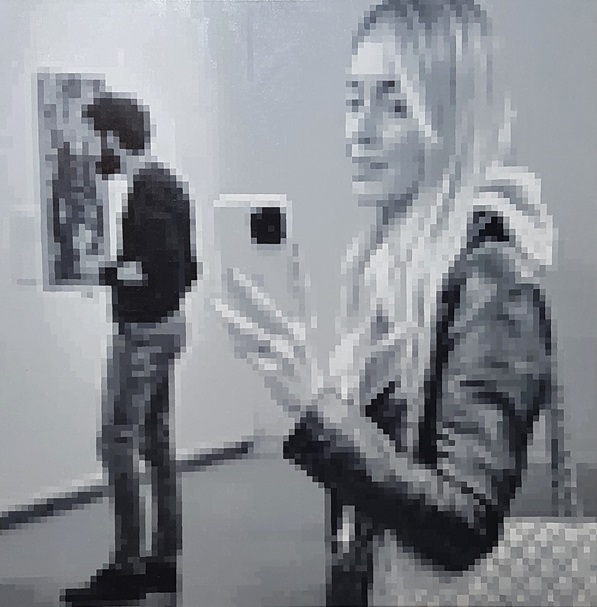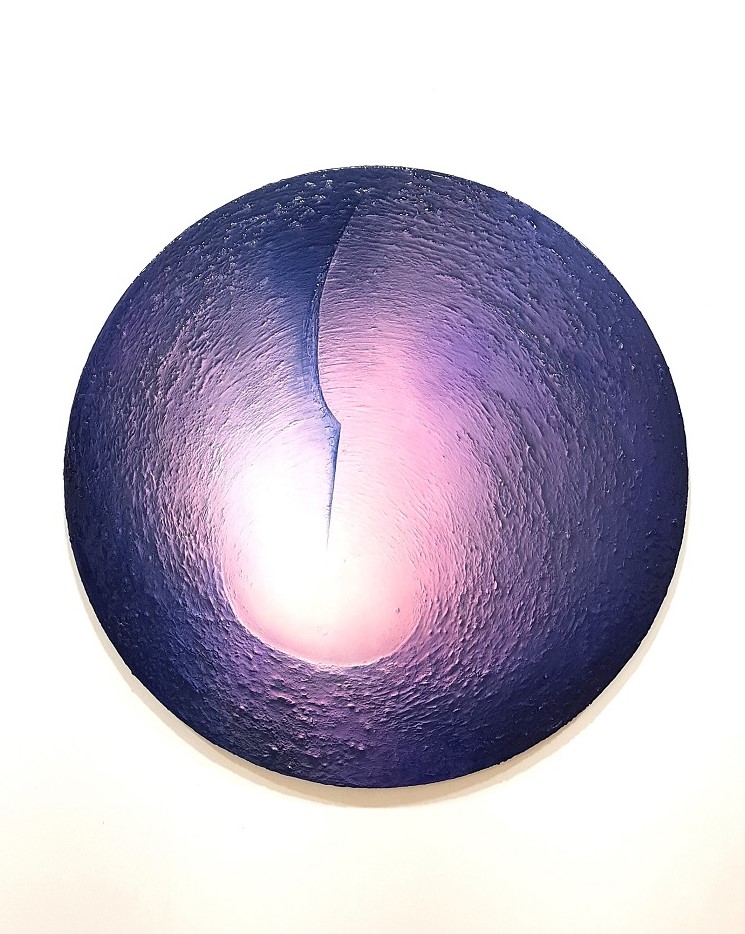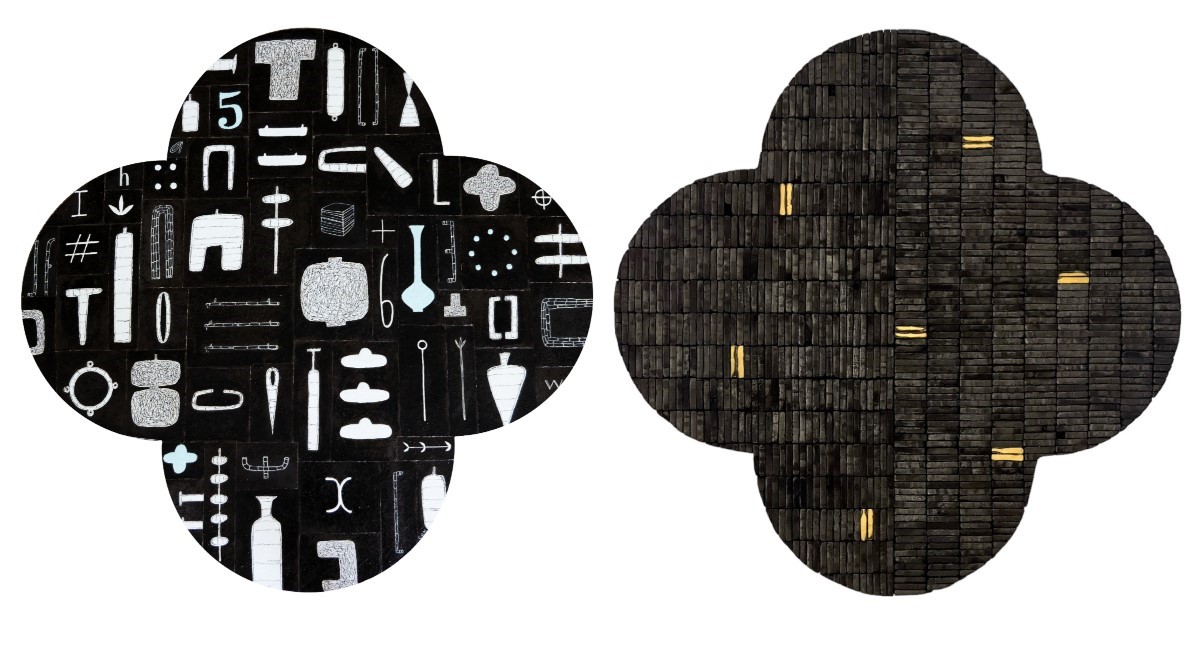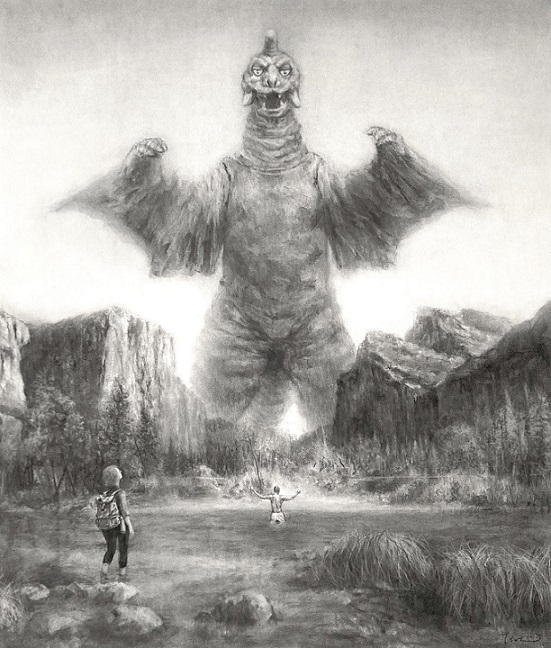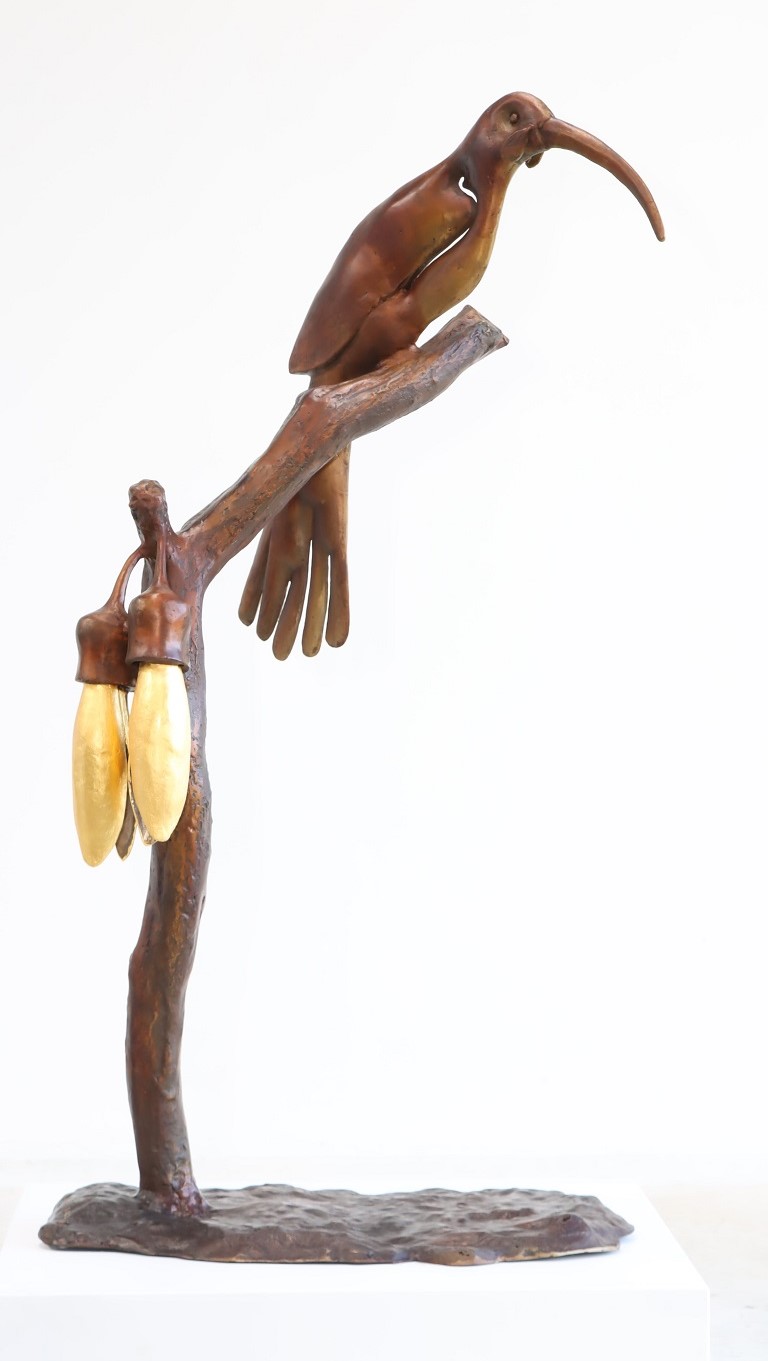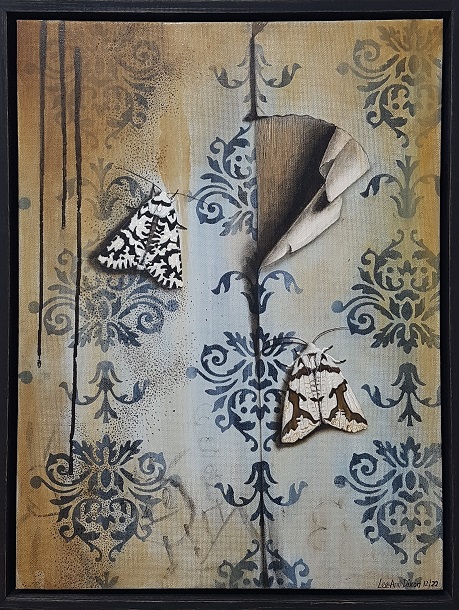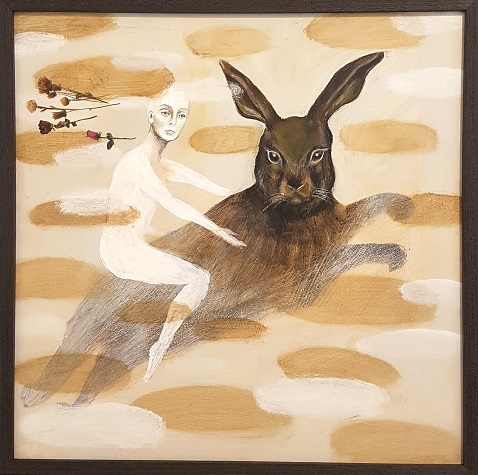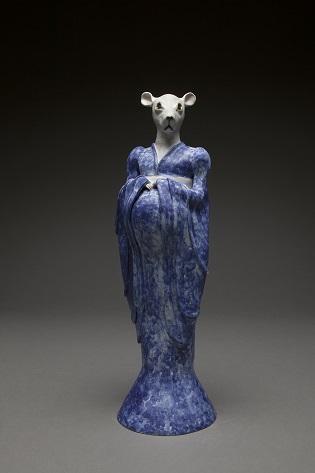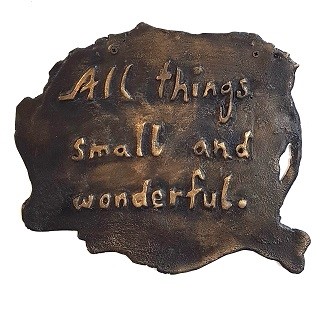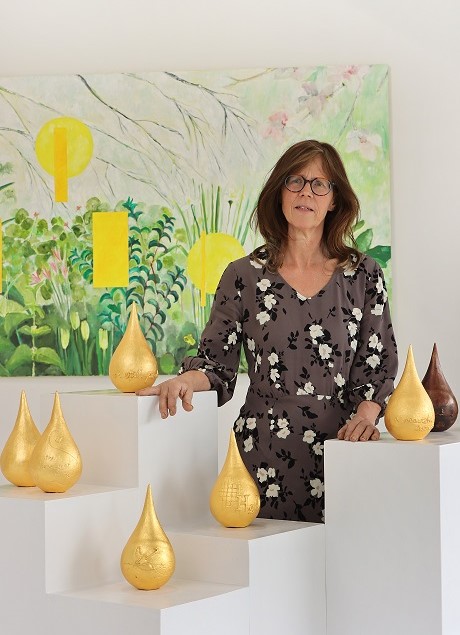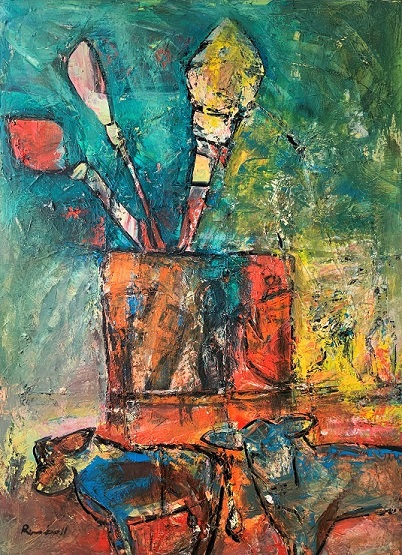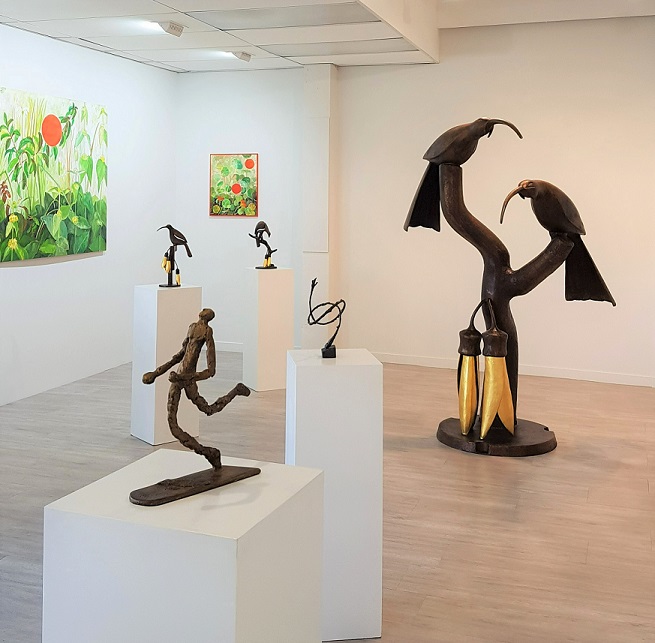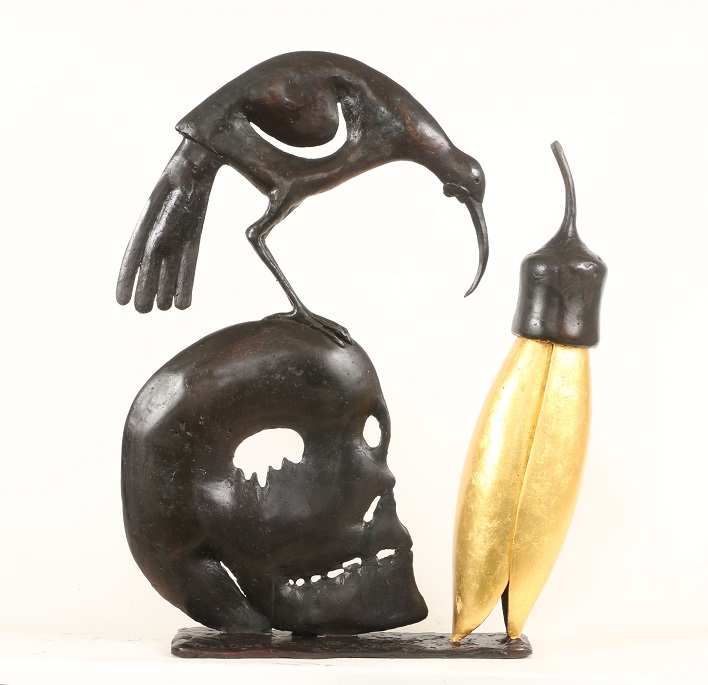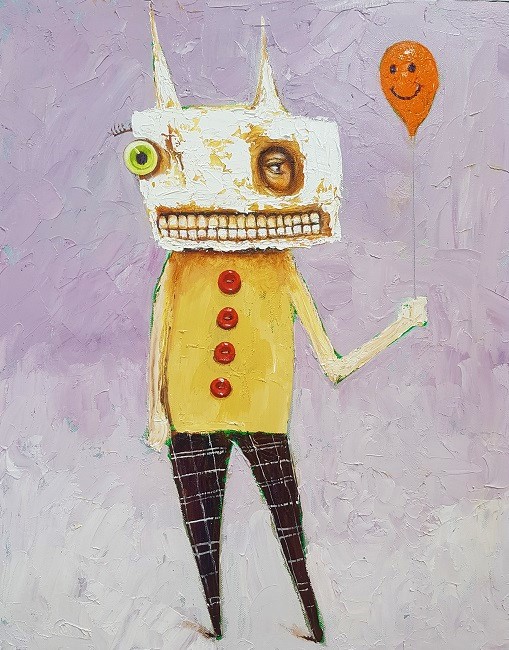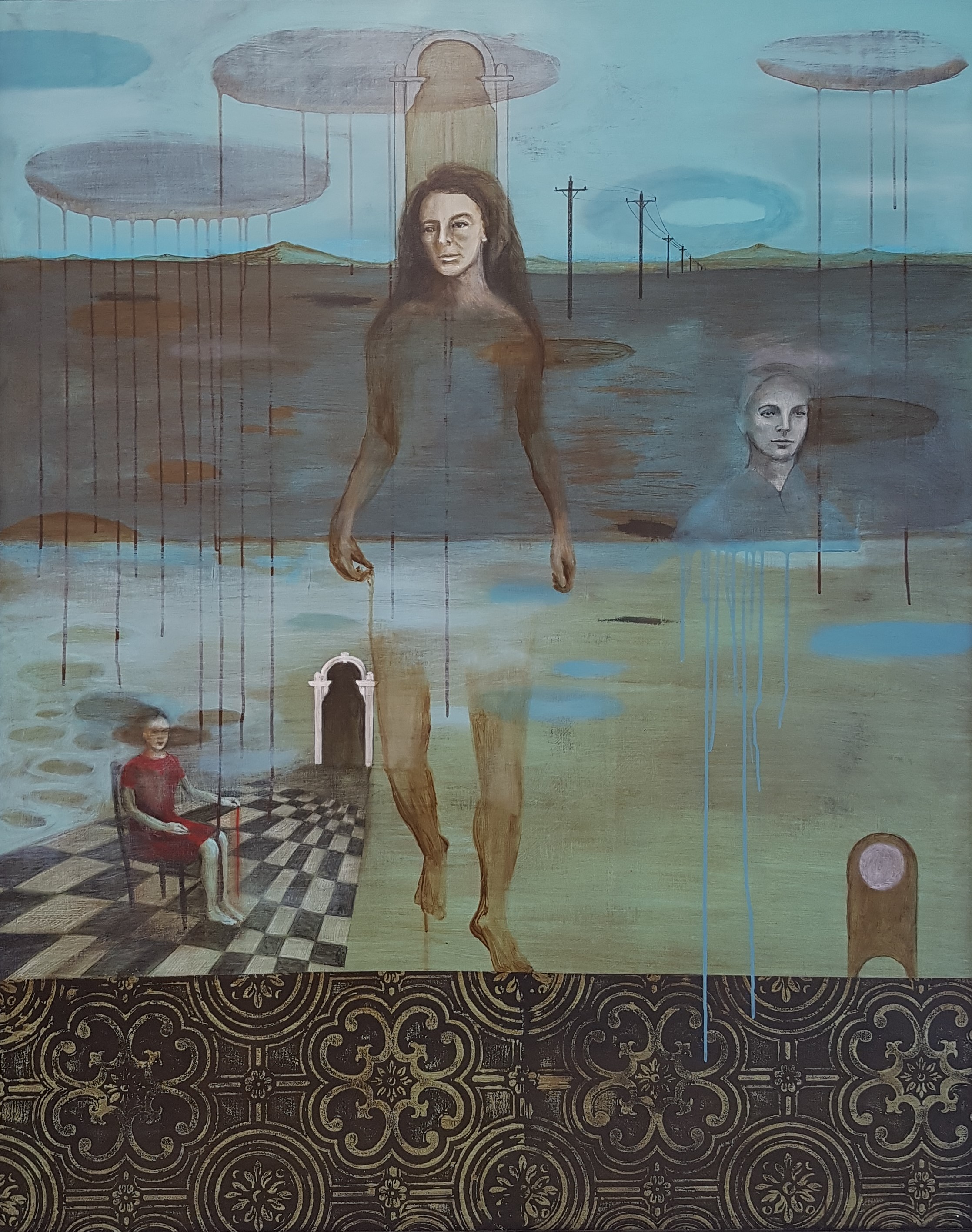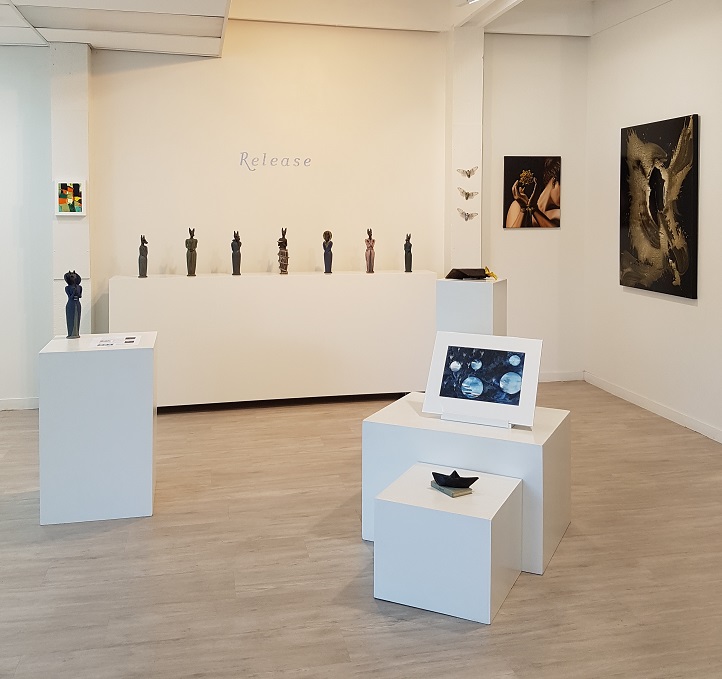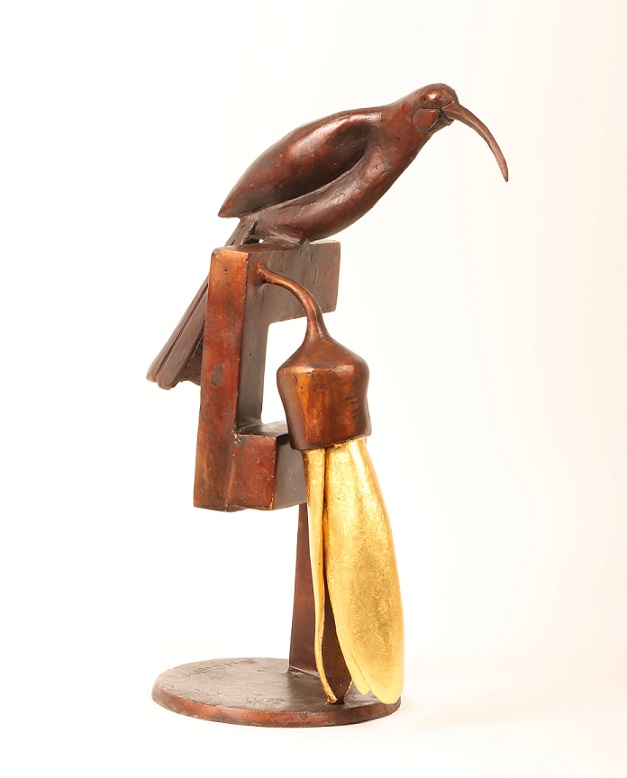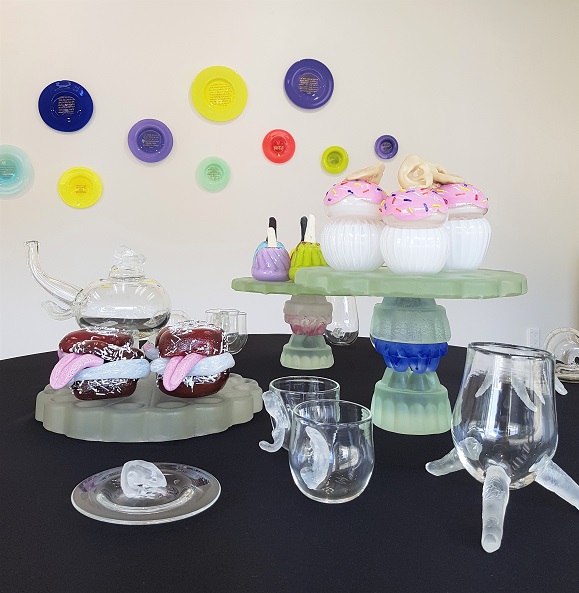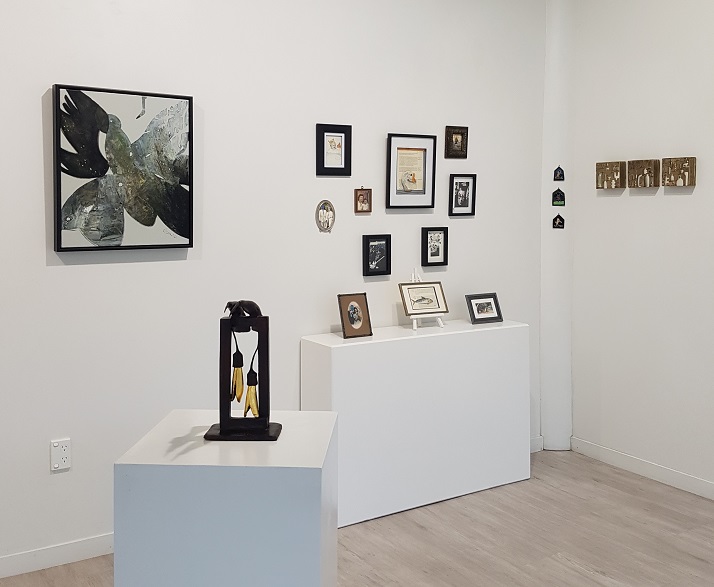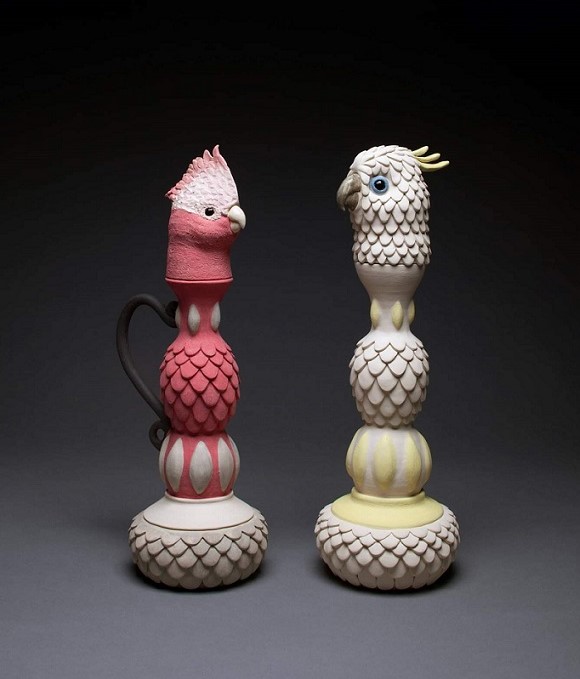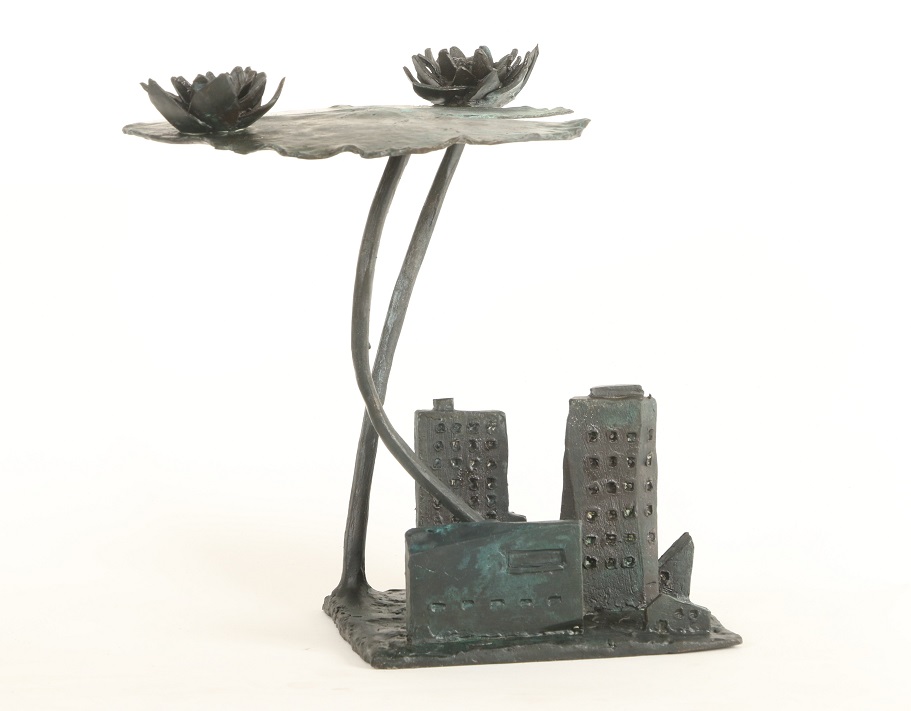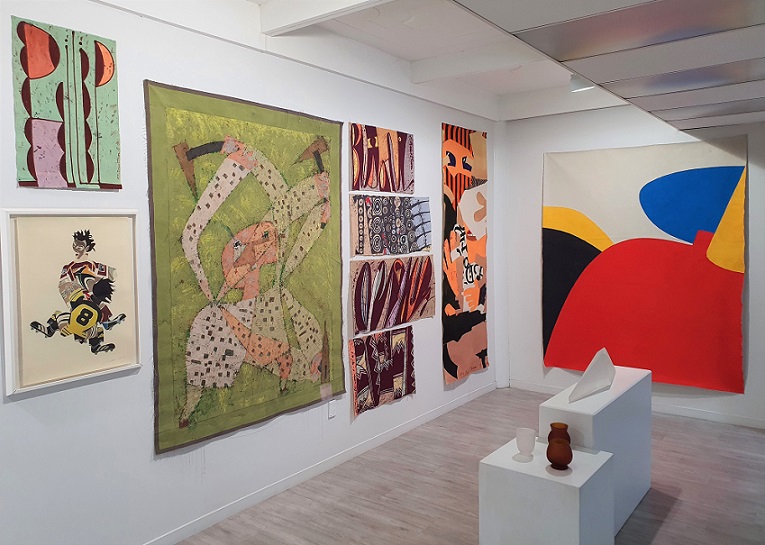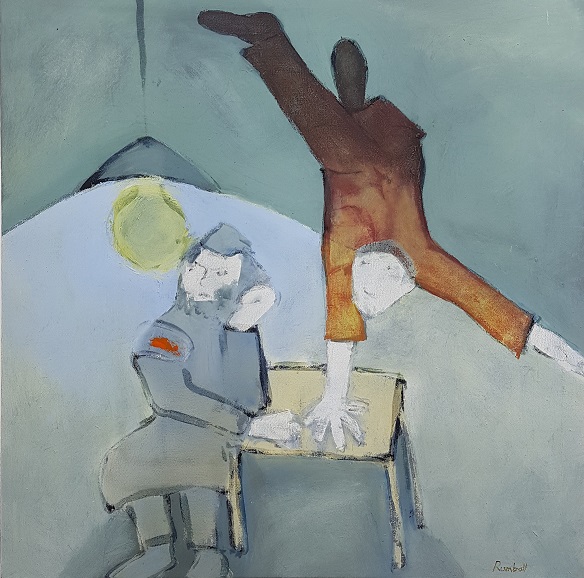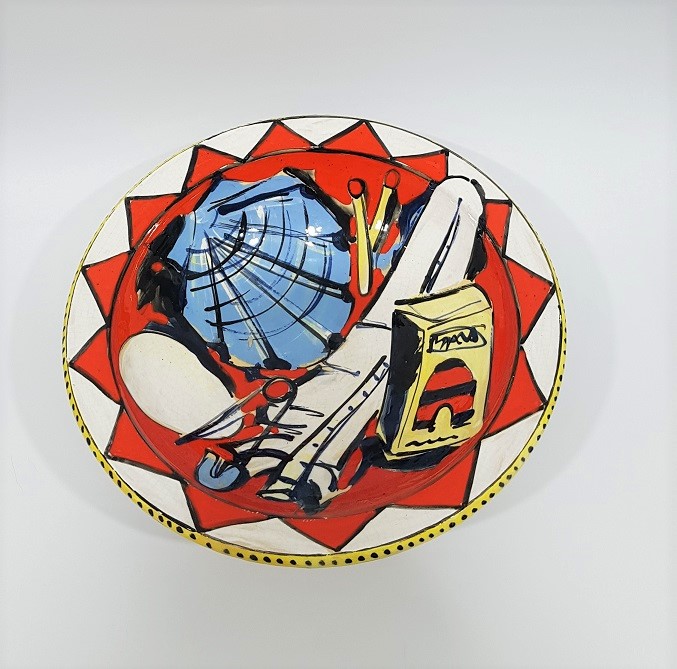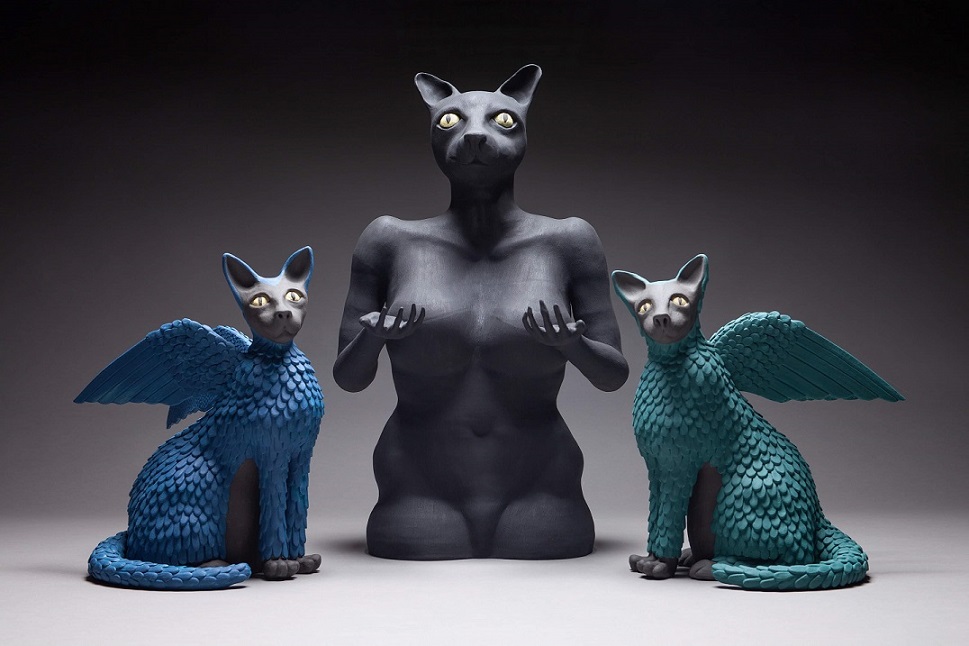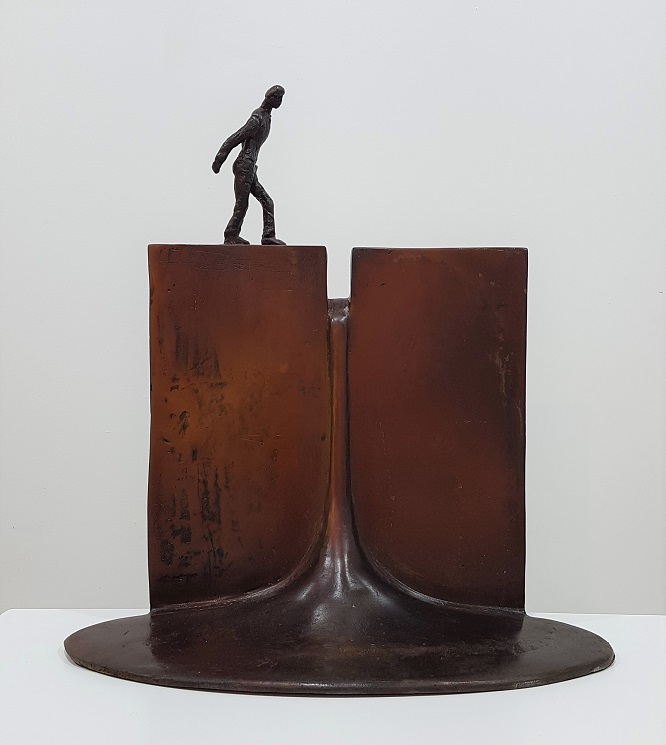Previous Exhibitions
November 2025 - oil paintings by Jennifer Baker
For November 2025, ZIMMERMAN is delighted to present a series of eight small oil paintings on board by Palmerston North artist Jennifer Baker.
Jennifer's paintings celebrate the transient beauty of flowers, and the simple beauty of everyday objects.
In 2024 Jennifer won First Prize in Palmerston North’s Studio on the Square Painting Competition, following on from her receipt of a merit prize in 2021. This year Jennifer received a Judges’ mention of excellence in the Manawatu Art Awards hosted by Feilding and District Art Society.
All works in this month's exhibition measure a petite 20 x 15 cm.
Come take a look - gallery open hours are 11am to 3pm Thursday to Sunday, or view the works 24/7 through the front window. Exhibition runs until Sunday 30 November.
October 2025 - Ian Chapman - Creature Comforts
For October 2025, ZIMMERMAN is delighted to present "Creature Comforts" by Ian Chapman.
The exhibition brings together an eclectic cast of characters - each designed by the artist, brought to life with 3D printing technology, then hand-painted with high quality acrylic paints.
The works fall into three distinct categories:
- Eleven "little folk" - small freestanding sculptures - ranging from 27cm to 31cm high
- Six wall-mounted heads - ranging from 42 cm to 56 cm high
- Two large freestanding sculptures - 80cm and 90 cm high respectively
Of these diverse characters, the artist says "For my part there is no deep and meaningful narrative I want to tell. I just want to present the characters and leave you, the viewer, to imagine their names, their stories, their place in the world, and what that world may be."
Come take a look - gallery open hours are 11am to 3pm Thursday to Sunday, or view the works 24/7 through the front window. Exhibition runs until Sunday 2 November.
September 2025 - Naga Tsutsumi
For September 2025, ZIMMERMAN is delighted to present new charcoal drawings by Naga Tsutsumi.
The exhibition comprises three distinct series:
- Six drawings from "The Towers" (these are all in vertical format)
- Two drawings from "Shops in Wrong Places" (with unexpected shops in forest settings)
- Three studies of "Phantom Dancers" (human monsters)
Information about each of the works in this month's exhibition is set out beneath the images below.
Commentary & details
The Towers
Six of the works in this month's exhibition are from a series Naga Tsutsumi calls "The Towers".
The inspiration for the series came from a trip to Japan, when Naga returned to the town in which he grew up.
Naga noticed a lighthouse on top of Enoshima Island had been replaced with a new contemporary-looking lighthouse.
“It was then I realised that the old retro looking lighthouse was actually part of my childhood landscapes – without it, something was wrong, and the scenery with which I was so familiar was gone.”
“I felt like drawing the lost lighthouse in vertical format, and this idea eventually evolved into a series of tower drawings.”
“Besides actual structural towers, a tree can be a tower, piles of clothes can be a tower, a standing person can be a tower.”
“Drawing in vertical format is one of the styles that makes me realise I am so Japanese, because it reminds me of the Japanese writing system, with its top-to-bottom movement.”
“And there has always been a symbol tower in the places I have lived – first the lighthouse on top of Enoshima Island, then the Space Needle in Seattle USA, and now the clocktower in Palmerston North.”
All works in "The Towers" series are charcoal on Fabriano paper, 157 x 63 cm
The Tower - Dream over 70 generations
I don't believe night dreams are passed down through the generations, even if we share the same DNA - yet what if tiny fragments of memories or subconscious might be left in DNA, which might affect our dreams? I'm no dream scientist or psychologist, but this is what I was thinking when creating this work. What if that small girl at the top is having the same dream that her ancient ancestor once had?
The Tower - Goddess of Laundry
In this drawing piles of dirty clothes become some sort of Goddess and angels. Are they helping with the washing … or reassuring us it's OK not to make ourselves clean all the time?
The Tower - Housing Development
I hate housing development, especially when it happens in my neighbourhood. I love New Zealand’s old houses, and the unique contemporary designer houses, but not mass prefabricated ones. They look so temporary and short-term, and not like something that will become part of a city’s history. Sometimes I wonder whether the developers are even thinking about the aesthetics of city landscapes, and considering a city’s history and culture. After completing this drawing, I noticed the shape of the tower was a bit like the lighthouse that used to be at the top of Enoshima Island in Japan.
The Tower - Modern Times
This work features an impossible machine-like tower operated by people. The machine produces nothing, and the workers don't know what they’re operating or why. The title “Modern Times” comes from a Charlie Chaplin movie that I saw probably 30 years ago. Without watching it again or referencing images from the movie, I simply applied my vague memory to this work. The inspiration for the gorilla clinging to the tower comes from another classical movie: King Kong on the Empire State Building.
The Tower - Normal Life
This work, which started as a tree drawing, turned into a picture of co-existence of people and other creatures. Although I don't feel much life energy in trees in my home garden, wild trees in the native bush seem to have an intent to live and survive – in an almost creature-like way.
The Tower - The Witness
Is the giant woman standing on the top of the building going to save the city? Or is she the one destroying it? That was the question I asked myself as I created this work.
Shops in Wrong Places
Two of the works in this month's exhibition are from a series Naga Tsutsumi calls "Shops in Wrong Places".
"There will never be a shop that doesn't need any customers. But when we fina a shop in the strangest place, we wonder who would come here to buy anything? There mush be some reason for its existence."
"Although I've never encountered a busy shop in an odd hidden place, I wish I would accidentally bump into one: a hidden-gem-like shop, in a wrong and impossible location".
Both works from "Shops in Wrong Places" are charcoal on Fabriano paper, 90 x 160 cm
Phantom Dancer studies
Three of the drawings in this month's exhibition are studies called "Phantom Dancers".
"Are we all two-faced, deceiving ourselves without knowing? What are where is the real me?"
"Once you start to doubt yourself, you become less sure of who you are. Do I have a monster inside me?"
The studies in the "Phantom Dancer" series are charcoal on Fabriano paper, 74 x 67.5 cm
Exhibition runs until Sunday 28 September - gallery hours are 11am to 3pm, Thursday to Sunday.
August 2025 - Brett a'Court - Revelations and Regrets
For August 2025, ZIMMERMAN is delighted to present Revelations and Regrets (Aotearoa New Zealand in the mid-19th century) - selected oil paintings on woollen blankets by Brett a'Court.
The artist’s use of woollen blankets as a medium is a metaphor and connection to colonisation, Christianity and the Māori prophets.
"During the mid-19th century, New Zealand saw a period of significant change and conflict."
"This era saw the beginning of the New Zealand Wars, and the rise of Māori prophets and the spread of many political movements combining Christianity and Māori spirituality."
"The landscape of Aotearoa also started to change with excessive logging, forests being cleared for farming and the decline of native wildlife".
The paintings in this exhibition feature people and stories from this era - an artist's commentary on each work is set out beneath the images below, together with an artist's biography.
Work details
Octavius Hadfield
Oil on woollen blanket, 460 x 360 mm
Note: This painting was a finalist in the 2025 NZ Paint and Printmaking Awards
Octavius Hadfield was a nineteenth century missionary in New Zealand. In 1860 he wrote a pamphlet called "One of England's Little Wars". It was a public appeal for justice over the government's unjust purchase of land in Waitara Taranaki.
Walter Buller Huia, Shot Charge No 6 (it seemed like a good idea at the time)
Oil on woollen blanket, 410 x 410 mm
Walter Buller was a nineteenth century naturalist who was born in New Zealand in 1838. He would shoot specimens of native birds for museums and collectors all around the world.
Buller’s book, A History of the Birds of New Zealand, recalls the following encounter:
“Whilst we were looking at and admiring this little picture of bird-life, a pair of Huias, without uttering a sound, appeared in a tree overhead, and as they were caressing each other with their beautiful bills, a charge of No. 6 brought both to the ground together. The incident was rather touching, and I felt almost glad that the shot was not mine, although by no means loth to appropriate the two fine specimens.”
Later in life Buller reflected on the sadness of the passing of the huia, which ironically became extinct partly from such practices.
Captain Cook / Captain Cooker
Oil on woollen blanket, 205 x 255 mm
Captain James Cook is credited with introducing pigs to New Zealand in the 1770s.
These pigs, often referred to as "Captain Cookers," became wild, and a source of meat for both Pākehā and Māori. Subsequently they destroyed native plants and wildlife.
In the 19th century, pigs and potatoes became an essential part of the traditional hākari (feast) for Māori hui (gatherings).
The Bible and the Coin
Oil on woollen blanket, 300 x 220 mm
In 1837, William Colenso printed the first copies of the Māori New Testament at Paihia in the Bay of Islands. Many Māori chiefs sent barefoot messengers a great distance in order to acquire a copy.
A messenger sent by chief Nōpera Panakareao arrived at Paihia after several days of journeying. A letter wrapped in folds of cloth around his head conveyed the request for a copy of the Māori New Testament, and the messenger carried a one-pound gold sovereign with which to procure it.
Colenso noted it was the first gold coin he had ever seen in New Zealand; a reflection of the thirst at the time for the Christian scriptures.
Tāmati Te Ito - The Lizard Eater
Oil on woollen blanket, 410 x 310 mm
Tāmati Te Ito Ngāmoke was a Taranaki prophet in the 1850's who interwove Māori spirituality with Christianity.
His principal mission was to free Taranaki from the influence of demons and their tapu (sacredness).
Te Ito would organise great bonfires of taonga (treasures), clothing and carvings associated with atua (ancestral spirits). Even lizards - which were deemed to be tapu or demonic - were burned and eaten. His movement and followers were called Kaingārara, the Lizard Eaters.
Initially perceived as a rival to the Parihaka prophets Te Whiti-o-Rongomai and Tohu Kākahi, in 1872 Te Ito joined the Parihaka community.
About Brett a'Court
Born in Christchurch in 1968, Brett a'Court is a full time artist.
Brett became interested in art at a very young age, finding meaning through painting early in life. His relationship with art quickly developed into a lifelong passion to seek truth and understanding, and to make a spiritual connection through his faith between the physical and metaphysical realms.
Delving into New Zealand history to explore events of the past, his work explores questions of identity and his place in Aotearoa.
Brett's current work examines colonisation and Māori history, in particular the Māori prophets of the past. His use of woollen blankets as a medium are a connection and metaphor between colonisation, Christianity and the Māori prophets.
In 2022 and 2025 Brett was a finalist in the Craig Aspiring Art Award, and in 2024 his entry received a merit award - the same year in which he was also a finalist in the Walker & Hall Waiheke Art Award.
Brett was a finalist in the 2023 Molly Morpeth Canaday Award, and was a finalist in the NZ Paint and Printmaking Awards in both 2023 and 2025.
Brett won the Hugo Charitable Trust runner-up award in the 2021 National Contemporary Art awards, and was a finalist in the awards again in 2022, 2023 and 2025.
Brett's work is found in both private and public art collections throughout New Zealand. The artist lives and works in Waipu, a small Northland town he moved to with his wife more than 25 years ago.
July 2025 - Tony Rumball - selected works
For July 2025, ZIMMERMAN is delighted to present colourful new works on canvas by Tony Rumball.
Acrylic ink – the medium used in these works, and known for its high fluidity and intense colours – perfectly complements the artist’s bold and expressive painting style.
The energetic cast of characters in these latest works portray a range of personalities and pursuits, from the farmer in A Stocktake with his arms protectively widespread across his treasured jersey girls, to the Arty Fellow animatedly painting up a storm indoors.
Dealing with Grapefruit shows a flame-haired lass busy at the kitchen bench, while A Very British Shrug features a bespectacled Englishman engulfed in a flurry of flags.
Instructions from Grandma and Match Point both take inspiration from cave paintings - the latter work reflecting Rumball's wariness of bulls (although his own bulls were "always hand-reared and friendly").
But the prize for pluckiness surely goes to the ladies in Moving but Mucky, as the determined duo perkily balance a pot-plant and puppy on their bicycle.
Feel welcome to stop by the gallery for a closer look - gallery hours are 11am to 3pm Thursday to Sunday - exhibition on now until 3 August.
Work details
A Stocktake (2024), acrylic ink on canvas, 510 x 610 mm
Arty Fellow (2024), acrylic ink on canvas, 610 x 510 mm
Dealing with Grapefruit (2024), acrylic ink on canvas, 760 x 510 mm
A Very British Shrug (2024), acrylic ink on canvas, 760 x 760 mm
Instructions from Grandma (2024), acrylic ink on canvas, 510 x 760 mm
Match Point (2025), acrylic ink on canvas, 610 x 910 mm
Moving but Mucky (2024), acrylic ink on canvas, 610 x 910 mm
June 2025 - EXTRA TIME - a group exhibition
For June 2025, ZIMMERMAN is delighted to present EXTRA TIME.
Expanding on the theme of last month's feature show, TIME, this month's exhibition introduces new works - each bringing a fresh perspective to the shared theme of TIME.
A commentary on each of the new works, and work details, are set out under the images below.
Gallery open hours are 11am to 3pm Thursday to Sunday - come take a look!
Commentary on the new works
Waiting for Time to Pass is one of the last works released by the late Paul Dibble – the bronze sculpture in this month’s exhibition being the model-sized study of a larger work.
From a longstanding series Paul dubbed “the geometrics”, the human form is redefined as simple geometric shapes – legs become cones, and heads are abbreviated to spheres, to create a nuanced sense of gesture. The figure in Waiting for Time to Pass, with her crossed arms and straightened back, suggests some endurance is required to reach the moment for which she waits.
Two paintings by Naga Tsutsumi reflect the artist’s enthusiasm for sci-fi while exploring the passing of time.
In the background of Time and Again is a local icon, the Palmerston North Clock Tower, depicted here in the form it took some decades ago, before a cross and lantern section were added to the top. In the foreground stands a time-weary figure, with white beard and walking cane, while above his head a spaceman floats in the clouds. The central figure is cloaked in ambiguity – does he represent past, present or future? Or might he be the personification of time itself - Father Time, that well known character across cultures around the world, manifested here in a distinctively Manawatu setting? Whatever his identity, the figure appears centrally positioned between an historical feature and an astronaut – standing as an intermediary between time past and a future yet to be explored.
A second painting by Naga, The Wrong Destination, shifts gears from the philosophical to the fantastical. A time machine hovers above a sunbathing cat, the outstretched feline untroubled by either the time travelling machine whirring above its exposed belly, or the peculiar rabbit by its side.
To the Unknown is a hand-forged steel sculpture by Sebastien Jaunas. The freestanding work, with its concentric swirls and radiating rays, suggests a portal; a virtual gateway or tunnel, from which we could pass from one place in spacetime to another. The sculpture is part of a continuing series of works by the Kapiti Coast-based artist, exploring equilibrium, space and movement.
By our Forefathers’ Hands by Bruce Luxford reflects on the spread over time of material affluence from urban to rural environments, and the resultant impact on the natural landscape. In the foreground of the painting is a thatched wooden shack; a simple building, but one able to serve the needs of those clearing the forest and working the land. Rising ominously in the background, just beyond a thinning stand of trees, is an imposing brutalist structure. The bold geometric forms and futuristic architecture are suggestive of how the aesthetics and technologies of the current age are now replacing the ways of the past.
The time intensive and almost meditative act of knitting – in which the project progresses slowly, stitch by stitch – is reflected in Mia Hamilton’s ink drawing, I knit therefore I am. Every hand drawn “stitch” in the work - like every second that passes - is never quite the same. The work is a testament to the value of each moment, the irregular beauty of objects made by hand, and the rewarding results that can flow from time spent on even simple repeated activities.
Time out for coffee can be a great way of escaping from the daily grind, taking a quiet moment to stop, relax and contemplate the world around us. Coffee and Cumulus Clouds by Matthew Steedman conveys this sense of time out and serenity, with cotton-like clouds floating behind a café-style coffee cup. Yet the sense of ease and enjoyment portrayed in this scene belies the time and labour-intensive process behind the creation of a large work such as this, in which each small pixelated square was meticulously painted by hand by the artist, one pixel at a time.
Work details
Paul Dibble
Waiting for Time to Pass model, bronze, edition of 10, 660 x 190 mm
Naga Tsutsumi
Time and Again, acrylic on paper mounted on board, 420 x 300 mm
The Wrong Destination, acrylic on paper mounted on board, 215 x 265 mm
Sebastien Jaunas
To the Unknown, hand-forged steel, 620 x 600 x 300 mm
Bruce Luxford
By our Forefathers' Hands, acrylic on canvas, 510 x 510 mm
Mia Hamilton
I knit therefore I am, ink on paper, 780 x 760 mm (framed size)
Matthew Steedman
Coffee and Cumulus Clouds, oil on canvas, 1000 x 1000 mm
May 2025 - TIME - group exhibition
For May 2025, ZIMMERMAN is delighted to present TIME - a group exhibition marking the gallery's 15th anniversary.
An exhibition commentary and work details are set out under the images below.
Gallery open hours are 11am to 3pm Thursday to Sunday - come take a look!
Exhibition commentary
The eclectic works gathered for this exhibition feature paintings on canvas and board, small freestanding textile sculptures, and wall-mounted works in ceramic, textile and steel - each work responding, in its own way, to the shared theme of TIME.
Anna Korver’s contribution is Flight Path: an installation of 18 painted steel darts.
“For me the darts represent a connection to childhood, through the game of paper planes which, as it turns out, is universal. The darts are about sending out a wish, not knowing where it will land, or where life will take us.”
The unexpected path that life can take is also reflected in Brett a’Court’s oil painting on woollen blanket, Kuīni. It draws on the true story of Caroline Perrett, an eight-year-old European girl who, in 1874, was kidnapped by a band of dispossessed Māori seeking utu.
“Adopted by the Māori tribe, she bore the name Kuīni for fifty years, during which she forgot her original name. She was recognised in 1926 (55 years later) by her niece, while standing with a group of Māori women in the main street of Whakatāne. Caroline chose to remain with her Māori husband, children and relatives.”
Blue Hour by Cam Munroe invites us to spend time contemplating an assemblage of enigmatic symbols. The painting is inspired by “the tranquil yet mysterious atmosphere of twilight … the fleeting moments between day and night”.
Day by Day by Fran Dibble represents time and change, with the reworking of a painting first exhibited in 2022. Originally blazing with the bright colours of summer, the formerly fierce red nasturtiums are now diffused with cool green hues. The wild garden bed - with all its flamboyant disorder - is now sectioned into squares, as if to suggest the different light on different days.
Ian Chapman’s painting, Awaiting Breakfast, recalls the mealtime often considered to be the most important of the day – a fairy-winged child and long-nosed dog expectantly wait for the call to come and eat.
Orchid Orbital in the Eternal Now by Jennifer Baker is inspired by - and a reworking of - Time Door Time D’Or by American pop artist James Rosenquist. Jennifer came across Rosenquist’s work in a book, shortly after she had been reading Samantha Harvey’s novella Orbital.
“Orchids, which in Ancient Greece symbolised virility, are one of earth’s oldest known flowers. Here, the orchids are set in space, a juxtaposition that redefines the term ‘ancient’, and completely subverts our rationalising comprehension of time. Conscious of the human desire to allocate meaning to existence within ‘eternity’, this work is a meditation on both the indefinable and the inexorable nature of time.”
Turn Back Time by Kirsty Gardiner recalls a scene from New Zealand’s history; a plump huia nests, encircled by a verdant blossoming forest. But this paradisal world was not to last, its passing and the desire to return to it suggested by the faux clockface framing the otherwise idyllic scene.
The fun and fantastical works of textile artist Michele Irving draw inspiration from Lewis Carroll’s White Rabbit (who’s always late), and the children’s game “What’s the Time Mr Wolf?”
A wall-hung work finds White Rabbit fast asleep, oblivious to the chimes of the cuckoo-clock above his bed, while a waistcoated White Rabbit anxiously pulls out his pocket watch.
Mr Wolf makes more productive use of his daylight hours, stirring up culinary treats in Baking Time and giving a spectacular performance in Magic Time – a wand in one paw, and a top hat (complete with a conjured-up rabbit) in the other.
Meanwhile, leaping breezily across the wall is Time Flies - a flying feline, sprting a hot-pink wristwatch.
A cheeky oil painting by Paula Clare King, my first protest, recalls “that time Sister Gerard told us girls weren’t allowed to do handstands at school”. A defiant schoolgirl kicks up her legs, assuming the forbidden upside-down pose.
Rounding out the exhibition are four small paintings by Tony Rumball, each depicting a runner or rugby player in his own race against time.
Work details
Anna Korver
Flight Path, steel & paint render, free-form installation of 18 darts, 1350 x 400 mm
Brett a’Court
Kuīni, oil on woollen blanket, 255 x 205mm
Cam Munroe
Blue Hour, acrylic & oil on canvas, 785 x 785 mm (framed size)
Fran Dibble
Day by Day, oil paint on board, 595 x 495 mm
Ian Chapman
Awaiting Breakfast, oil on canvas, 910 x 610 mm
Jennifer Baker
Orchid Orbital in the Eternal Now, oil on wood panel, 400 x 350 mm
Kirsty Gardiner
Turn Back Time, mixed media, 255 x 205 mm
Michele Irving
- What’s the Time Mr Wolf? - Baking Time, freestanding textile, 160 x 50 x 130 mm
- Am I late? - White Rabbit, freestanding textile, 160 x 90 x 70 mm
- What’s the Time Mr Wolf? - Magic Time, freestanding textile, 170 x 90 x 130 mm
- Tick Tock - the White Rabbit Slept Late, wall-hung textile, 210 x 170 mm
- Time Flies – Flying Feline, wall-hung textile, 160 x 220 mm
Paula Clare King
my first protest, oil on board, 830 x 630 mm (framed size)
Tony Rumball
- A Personal Best, acrylic & ink on canvas, 410 x 300 mm
- Oldtimer, acrylic & ink on canvas, 410 x 300 mm
- Running Down the Clock, acrylic & ink on canvas, 410 x 300 mm
- Time to Step Up, acrylic & ink on canvas, 410 x 300 mm
April 2025: Kirsty Gardiner - Simple Abundance
For April 2025, ZIMMERMAN is delighted to present Simple Abundance:
a collection of new works by Kirsty Gardiner.
Simple Abundance: The Inner Journey
Simple (adj) 1: without embellishment. 2: clarity of form and thought. 3: fundamental.
Abundance (n) 1: an ample quantity, profusion. 2; wealth. 3: plentifulness.
Simple Abundance 1: an inner journey. 2: a spiritual and practical course in creative living. 3: a tapestry of contentment.
Quote from Simple Abundance: A Daybook of Comfort & Joy by Sarah Ban Breathnach, and the inspiration for this collection.
Easter and ANZAC hours:
Thursday 17 April - 11am to 3pm
Good Friday - closed
Saturday 19 April - 11am to 3pm
Easter Sunday - closed
Monday 21 April - 11am to 3pm
Tuesday 22 April - 11am to 3pm
Wednesday 23 April - 11am to 3pm
Thursday 24 April - 11am to 3pm
ANZAC Day - closed
Saturday 26 April - 11am to 3pm
Sunday 27 April - 11am to 3pm
Featured works
All works are individually available:
True North - eight faux ginger jars - approximately 200 x 90 x 90 mm
Buried Dreams - five large faux urns - approximately 630 x 220 mm
Simple Abundance - four wall-mounted arches - approximately 260 x 170 mm
Slipper Moths - new moth design, wall-mounted - 150 x 140 mm
Bee Garden - new bee design, wall-mounted, various colours - 80 x 90 mm
Satin Moths - new moth design, wall-mounted, various colours - 120 x 150 mm
March 2025 - New Day Rising! - paintings by Campbell Kneale
For March 2025, ZIMMERMAN is pleased to present New Day Rising!:
a series of eight paintings by Campbell Kneale.
The artist's commentary for the exhibition is set out under the images below.
All works in "New Day Rising!" are acrylic on card, framed size 865 x 620 mm
Artist's commentary
New Day Rising! is a charting of intensity and experience, an embodied means of processing the daily triumphs and tribulations of weathering relationship detonations, insecure employment status, transience and permanence, and separation from friends and family as the artist moves to put down brand new roots in the strange places the path less travelled takes him.
Ear-worms, synchronicities, and recurring dreams lie heavily over these multi-faced and somewhat allegorical ‘self-portraits’ like a damp blanket, scratching a universal itch for understanding, belonging, and security amidst profound disorientation.
Brief artist bio
Campbell Kneale is an internationally recognised sound artist.
He first came to critical attention in the late 1990s helping to create a blueprint for the liberties that the home recording format could offer. The next 20 years saw him record over 200 audio releases, as well as embarking on a relentless touring schedule that took him on near permanent rotation throughout Europe, USA, Asia, and Australia.
Campbell’s visual art practise initially found its way into the world through the democratic format of the album cover. His work has been exhibited in a range of New Zealand venues, from established public galleries to grungy artist-run spaces.
In the Covid years Campbell began painting cats - irreverent, house-bound, badly behaved cats, the popularity of which enabled him to relinquish formal employment for a time, to paint under the pseudonym CATMAN (@catmanlistens).
Campbell recently moved to Taihape, where he currently works as a high school Art Teacher.
February 2025 - Regrowth - oil paintings by Fran Dibble
This February 2025, ZIMMERMAN is pleased to present "Regrowth" - a series of oil paintings by Fran Dibble.
The artist's commentary for this exhibition is set out under the images below.
Gallery open hours are Thursday to Sunday 11am to 3pm (including Waitangi Day) - come take a look!
Fran Dibble - artist's commentary on this exhibition
"The paintings in this series, as in other series over the years, are about order.
These are compositions of wild, random gardens with some element of precision placed on them – perfect circles, in one a gold orb, squares or a white windowsill.
It may remind us that this is a painting, and not a view out the window.
But the intent is a play off, each element a foil to the other; the random quality emphasised by the sudden oddity of such a precise shape, this appearing more exacting from the backdrop of busy expression.
The paint technique is applying it almost like a tapestry.
A small brush swerves and glides over the surface, dabbing colour and flicking lines.
It is not impressionist dashes to portray different light, but more as if stitched in paint; the painter in a role more as embroiderer.”
Exhibition runs until Sunday 2 March
Painting details
All paintings are oil on board by Fran Dibble, 2025
- A View to the Clearing, 80 x 100 cm
- Bright Circles, 70 x 60 cm
- Busyness Beyond, 60 x 80 cm (includes three cast bronze leaves)
- From Busyness into a Still Room, 100 x 80 cm
- From Stillness into a Busy World, 100 x 80 cm
- Order in a Chaotic Garden, 110 x 120 cm
- The Beauty of Structures, 100 x 80 cm (features 24 carat gold gilding)
Dec 2024 / Jan 2025 - All things small and wonderful - group exhibition
To end 2024 and welcome the new year ahead, ZIMMERMAN’s summer exhibition celebrates art works that are "small and wonderful".
As works leave this evolving exhibition, new works will progressively be added to take their place - come take a look when you're out and about this summer.
The gallery is open 11am to 3pm every day until Christmas Eve, then re-opening Thursday 16 January 2025.
All things small and wonderful
ZIMMERMAN’s summer exhibition showcases works that are “small and wonderful” – with art works by nine artists opening the show, and works of other artists set to arrive in the weeks ahead.
Exhibiting at ZIMMERMAN for the first time is Palmerston North artist Jennifer Baker, with a selection of small oil paintings on board featuring arrangements of foraged flowers.
Sculptor Justin Cook delights with his ceramic series of "Neigh Sayers" - miniature horses, each carrying an object or animal, bringing different conversation points to discussions about a changing climate.
Gallery regulars will recognise the distinctive works of Cam Munroe and Claudia Aalderink - Cam best known for her paintings featuring various pictorial symbols and icons, and Claudia repurposing recycled beehives to dramatic effect.
The psychedelic abstract paintings of Deano Shirriffs are also readily recognisable - December's offering featuring a tondo in pink and blue hues.
There is a series of stacked bronze objects by Fran Dibble, the largest featuring two sentinel cats perched watchfully atop a gourd.
Felines also feature in the pulp art paintings of Roger Key: in "Catatonicus Amusecus" a nonchalant cat watches as the city outside is under attack, while the cats in "Splootation Spacecation" stroll and sploot on an interplanetary vacation.
A variety of ceramic works by Kirsty Gardiner include a quirky new series, "Not made by Gran", featuring crochet flowers bursting forth from wheel thrown pots. Owls peep out from embellished "Prickly Pears", birds perch on cotton-reel stands, magnolias bloom from petite pots, and a trio of moths have alighted on the gallery walls.
Textile artist Michele Irving imagines a fantastical world of party animals with wings: Esme in her pretty pink dress, and Jesse in a stylish tunic. And a new series of brooches, each complete with its own presentation tin, is a perfect package for holiday gifting.
Come take a look this summer, at this evolving exhibition of small and wonderful works of art.
ZIMMERMAN is open 11am to 3pm every day until Christmas, then re-opening on Thursday 16 January 2025.
November 2024: Art Collection of Hendrika Hoogendyk
On behalf of Arohanui Hospice, this month ZIMMERMAN is delighted to present the art collection of the late Hendrika Hoogendyk.
Every art work in this month’s exhibition is available to purchase, with Hospice receiving 100% of the proceeds of sale.
The works range from European landscape scenes, painted in the late 1880s by established overseas artists, to works by contemporary New Zealand artists created as recently as 2023.
Two large paintings by Jack Register depict views of Foxton Beach, while native birds feature in a number of paintings and prints, including four limited edition prints by Bruce Harvey.
So there’s something for every taste and budget in this month’s exhibition, as well as a unique opportunity to support Hospice’s work in our local community.
Come and take a look this month, and be sure to spread the word!
Remembering Hendrika Hoogendyk
Born in Quebec, Hendrika made New Zealand her home, where she combined a career in law with her dedication to the arts.
Hendrika loved literature, art and the natural world. The serene beauty of New Zealand’s beaches, where she found peace and inspiration, is mirrored in many of the works she collected.
Hendrika’s art collection is testament to her lifelong engagement with the arts, and offers a glimpse into the things that brought her joy and fulfilment.
Exhibition runs until Sunday 1 December – gallery open hours 11am to 3pm, Thursday to Sunday each week
October 2024 - Dan Dibble - selected sculptures
For October 2024, ZIMMERMAN is delighted to present the first solo exhibition of sculptures by Dan Dibble.
Some of the works featured in this month’s exhibition test the limits of the bronze casting process; other works test the limits of Dan’s sculpting abilities, from modelling detail to capturing form.
The exhibited works are diverse - there is a virtual garden of freestanding flower sculptures, a collection of exuberant spiral forms, and two large “walkers” on the land.
But perhaps the stars of this month’s show are Dan’s “huia people” – the sculptures with huia heads and human forms, which give the sculptor scope to portray a wide span of expression and emotion.
Dan’s huia people range from figures that appear cool and aloof, to those that are animated and engaging.
One work, The Lovers, depicts a male and female figure gracefully intertwined.
Dan considers the huia people he has created to date “barely scratch the surface” as to the possibilities that lie ahead – be sure to watch this space!
FEATURE EXHIBITIONS
September 2024 - "UP" - a group exhibition
September 2024 brings together the works of 12 artists in response to the theme UP:
Angela Tier - ceramic sculpture
Brett a’Court - oil painting on woollen blanket
Cam Munroe - mixed media paintings on shadow cladding
Claudia Aalderink - composition from charred recycled beehives
George Agius - hot sculpted glass sculptures
Justin Cook - ceramic sculpture series
Matthew Steedman - oil painting on board
Michele Irving - mixed media wall hangings & wearable art (brooches)
Naga Tsutsumi - charcoal drawings on Fabriano paper
Sean Crawford - wall mounted sculpture composed from resourced table leg, laser cut steel and powder coat render
Sebastien Jaunas - free-standing and wall-mounted forged steel sculptures
Tony Rumball - oil paintings on canvas
Information on each artist’s works is set out under the images below - be sure to stop by the gallery this month for a closer look!
Work details
Angela Tier
Flamingo Urn (2024), ceramic, 560 x 160 x 140 mm
Brett a’Court
Tohu Rises Up (2024), oil on woollen blanket on board, 400mm x 300mm
"Tohu Kākahi and Te Whiti-o-Rongomai were Māori prophets, who led a peaceful resistance against government forces over land acquisition at Parihaka.
Tohu had a vision in which the biblical prince of peace, Melchizedek, came to him, confirming his position as a leader within the Parihaka movement.
Tohu's descendants tell how the Parihaka movement was given divine sanction by the Holy Spirit in the form of an Albatross, later validated by a comet seen over Mt. Taranaki in 1882."
Cam Munroe (individually available)
The only way is 1 (2024), acrylic & mixed media on shadow cladding (framed), 710 x 270 mm
The only way is 2 (2024), acrylic & mixed media on shadow cladding (framed), 710 x 270 mm
Claudia Aalderink
One Tree Hill (2023), charred recycled beehives on plywood (framed), 330 x 330 x 50 mm
George Agius (individually available)
Somnus Moe #1 - #5 (2024), hot sculpted glass, each approximately 160 x 250 x 100 mm
Justin Cook
Rituals (2022-23), ceramic sculptures (individually available):
Huia (extinct), 120 x 130 x 300 mm
New Zealand Goose (extinct), 200 x 100 x 100 mm
Kakapo, 150 x 140 x 150 mm
Giant Gecko (extinct), 190 x 140 x 80 mm
Haast Eagle (extinct), 220 x 180 x 180 mm
"This series is based on the concept of emerging technologies relating to genetic engineering and cloning.
Whilst we haven't yet perfected the 'dance' or 'magic combination of moves', in the near future there is a real possibility that de-extinction could be possible.
The 'angels with dirty faces' in this series represent the next generation of scientists who will possibly, and probably, have the right tools to do the job."
Matthew Steedman
All Fired Up (2024), oil on board, 500 mm diameter
"All Fired Up is inspired by the groundbreaking work at CERN’s Large Hadron Collider, where subatomic particles collide at incredible speeds, unlocking new realms of scientific discovery.
This painting captures my vision of such a collision; an explosion of energy and color, where chaos and beauty coexist."
Michelle Irving (individually available)
Flying Feline – Take Off (2024), mixed media wall hanging, 305 x 90 mm
Flying Felines (2024), mixed media wearable art (brooches) - black 60 x 70 mm / ginger 45 x 60 mm
The Amazing Zephyr Cats (2024), mixed media wall hanging, 385 x 80 mm
The Tucci Trio – Woof (2024), mixed media wall hanging, 340 x 120 mm
Naga Tsutsumi
The Tower (2024), charcoal on Fabriano paper, 1100 x 670 mm
Toward the Light (2024), charcoal on Fabriano paper, 780 x 400 m
Sean Crawford
Ngā Anahera i Taku Tēpu - Angels At My Table (2024) - resourced table leg, laser cut steel with powder coat render, 720 x 450 x 230 mm (shown here on both white and black backgrounds)
"In this sculpture a wooden table leg, still carrying its historical markings, no longer supports a physical platform. Free from the burden of function, it becomes a burnt totem - ready for adornment. This reference to a foundation without function challenges pre-existing societal norms by subverting an object that no longer supports anything more potent than meaning.
The introduction of the Kōtuku (White Heron) maps the transference of life force from the living (or natural) world into the celestial realm (Reinga). Set like handles of a vessel yet to be filled, the work depicts a portal between two worlds, as the birds emerge from a space that cannot hold them. Both Kōtuku heads are fabricated from metal Puawhananga (the New Zealand Clematis) which symbolizes an earthly star.
In white, the heron is shown in its natural hue. The lace like petals, reminiscent of the white tablecloths of yesteryear, gently caress the table-leg as if in mourning for ‘what was’. Juxtaposed in red, the heron becomes the celestial body - a bringer of intense energy.
And the table leg, forever marked by the scorching heat that circled it, represents change, hope and the power of transformation."
Sebastien Jaunas
Elevation (2024), hand forged steel, 795 x 130 x 200 mm
Untitled (2024), hand forged steel & paint (wall mounted), 1940 x 720 x 180 mm
Tony Rumball
Up From Tarata (2024), oil on canvas, 910 x 610 mm
Mounted (2024), oil on canvas, 760 x 500 mm
UP is on display until Sunday 29 September – gallery open hours are 11am to 3pm Thursday to Sunday each week
August 2024 - Ian Chapman - A Midsummer Night's Dream
For August 2024, ZIMMERMAN is delighted to introduce a series of sculptural works by Masterton artist, Ian Chapman.
The exhibition features 11 wall-mounted robot busts. Each is 3D-printed from the artist's original designs, then hand-painted with acrylic, enamel and oil paints, making every robot distinctive and unique.
Here the robots are cast as characters from Shakespeare’s comedy, A Midsummer Night’s Dream. The actors assembled for this show include the impish Puck, the strong-willed fairy queen Titania, the fiery Oberon and the comic Bottom.
The artist notes "AI may be able to produce art, but will it ever be able to truly create original works? Will it understand what it is to create - or what indeed it has created - and what it may mean to another?
The robots in this show are actors portraying characters. They may deliver the lines perfectly, but may never understand the nuances, humour and imperfections of the people they are portraying - and is it even their place to do so?"
A full artist's statement, work details and brief artist's bio are set out beneath the images below.
Artist's statement for A Midsummer Night's Dream
“An infinite number of typing monkeys, given an infinite amount of time, will eventually type the works of Shakespeare.
Note that I say type and not create. The creating is what is important.
AI may be able to produce art, but will it ever be able to truly create original works? Will it understand what it is to create - or what indeed it has created - and what it may mean to another?
The robots in this show are actors portraying characters. They may deliver the lines perfectly, but may never understand the nuances, humour and imperfections of the people they are portraying - and is it even their place to do so?
I want robots (AI) to do the jobs that I don’t want to do, so that I have more time to create - not the other way round!”
Robots featured in these images
- Bottom (blue with red eyes) - 290 x 260 x 230 mm
- Demetrius (bronze with red eyes) - 290 x 280 x 210 mm
- Flute (beige with blue eyes) - 310 x 220 x 230 mm
- Helena (orange with blue eyes) - 290 x 280 x 200 mm
- Hermia (light blue with red eyes) - 270 x 230 x 220 mm
- Hippolyta (cream with blue eyes) - 310 x 240 x 240 mm
- Lysander (bronze with blue eyes) - 290 x 220 x 210 mm
- Oberon (red with blue eyes) - 300 x 270 x 260 mm
- Philostrate (bronze with blue eyes) - 310 x 230 x 230 mm
- Puck (rusty with red eyes and pink smile) - 270 x 200 x 180 mm
- Titania (pink with blue eyes) - 300 x 230 x 220 mm
All works are by Ian Chapman (2024), 3D-printed PLA, acrylic, enamel & oil paints
Ian Chapman – brief artist bio
Born in Brighton, England, Ian Chapman trained in Visual Art at Masterton Polytechnic in the Wairarapa. Ian has been involved with King Street Artworks in Masterton since its inception in 1997, first as a tutor and now as Manager.
Ian describes himself as "Mr Bean and George Clooney's love child. Desperately normal on the outside and a little irregular on the inside. Or is it the other way round?"
Key influences in his work include 50's sci fi, steampunk, antique toys and "anything retro".
Exhibition runs from 1 August to 1 September 2024, gallery open 11am to 3pm Thursday to Sunday
July 2024 - Paula Clare King - selected works
For July 2024, ZIMMERMAN is delighted to introduce the works of Manawatu poet and painter, Paula Clare King.
An artist's statement, brief artist's bio and image details are set out beneath the images below.
Artist's statement
"I don’t know what I am painting until I’ve finished a work, trusting the paint pigment will guide me.
I’ve come to realise that the images come from memory, dreams, my subconscious and my positioning of the present.
I like this way of painting as it often surprises me.
Reflecting on my work to date, I see myself trying to explore themes of space, place and belonging, body and invasion through landscape.
I am trying to reveal my reflections on the interplay of the past, present and future – human interactions, power imbalances on/with the landscape and each other.”
Paula Clare King – brief artist bio
Paula Clare King has a Master’s Degree in Education, an MA in creative writing from the International Institute of Modern Letters and a Post-Graduate Diploma in Māori Visual Art.
Paula was a finalist in the New Zealand Painting and Printmaking Awards 2024 for her oil painting “prayer for us” - this painting is one of the works on display in this month’s exhibition.
Paintings featured in this month's exhibition:
Figure in the landscape - it's mine, no it's not (2024), water mixable oils on wood, 920cm x 920 mm (framed size)
Golgotha (2024), water mixable oils on board, 280 x 280 mm
Waiting (2024), water mixable oils on board, 270 x 280 mm
it's mine and I can do what I want (2023), water mixable oils on board, 515 x 1220 mm (framed size)
earthworks volume 2 (2004), water mixable oils on board, 500 x 1220 mm
movement effects condition (2024), water mixable oils on wood, 950 x 950 mm (framed size)
my congregation (2022), water mixable oils on wood, 570 x 840 mm (oval, framed size)
not my favourite knowing (2023), water mixable oils on wood, 300 x 300 mm
overstanding (2023), water mixable oils on wood, 580 x 360 mm (painted on an old kitchen cupboard door)
prayer for us (2024), water mixable oils on canvas, 900 x 600 mm (framed size) - NZPPA Finalist 2024
strong woman with things done to do and be (2023), water mixable oils on wood, 300 x 300 mm
June 2024: "Back to Front" extended - group exhibition featuring works from the back gallery
For June 2024, ZIMMERMAN extends the warmly received exhibition Back to Front, with new works brought out from the back gallery to the front.
The exhibition is a reminder that, behind the front gallery walls, there is a larger gallery out the back, displaying a variety of works by the artists ZIMMERMAN represents.
Here you'll find works by your favourite artists in between feature shows, early pieces, and works fresh from the artists' studios.
Art work details are beneath the images below - extended exhibition runs until Sunday 30 June 2024
Paul Dibble: The Proposal study 2 (2019), bronze, 335 x 110 x 190 mm, edition of 10 + AP / The Quest for Immortality (2023), bronze, 440 x 220 x 80 mm, edition of 10 + AP
Cam Munroe: Liquid Mind (2014), acrylic & mixed media on canvas, 510 x 970 mm (framed size)
Anna Korver: Life boat with gold tree (2024), African wood, 570 x 100 x 65 mm
Sebastien Jaunas: Cathedral II (2021), hand forged steel, 1680 x 500 x 480 mm
Matthew Steedman: Woman Vaping (2021), oil on canvas, 500 x 600 mm
Sean Crawford: Urban Chorus (2023), laser cut Corten steel, powdercoat render and electrical wiring, 880 x 360 x 370 mm
Deano Shirriffs: All things small and wonderful (2022), mixed media on board, 400 mm diameter
Sebastien Jaunas: Spring III (2022), hand forged steel, 565 x 170 x 200 mm
Kirsty Gardiner: Release (2023), earthenware and mixed media, 600 mm diameter
Dan Dibble: The Guardian (2023), bronze and 24 carat gold gilding, edition of 10 + AP, 740 x 180 x 200 mm
Paige Williams: Blue Penguin (2019), acrylic on board, 320 x 270 mm (including frame
Kirsty Gardiner: Leverage the Negative Space (2024), earthenware and mixed media, 190 mm diameter
Anna Korver: Black facet figure (2024), Corten steel, 1010 x 160 x 160 mm
Kirsty Gardiner: Ceramic moths (2024), ceramic and mixed media - small 110 x 150 mm / medium 130 x 190 mm / large 140 x 220 mm
May 2024: "Back to Front" - group exhibition featuring works from the back gallery
For May 2024, ZIMMERMAN presents Back to Front - a selection of art works not previously featured in a front gallery show.
The exhibition is a reminder that, behind the front gallery walls, there is a larger gallery out the back, displaying a variety of works by the artists ZIMMERMAN represents. Here you'll find works by your favourite artists in between feature shows, early pieces, and works fresh from the artists' studios.
Come take a look this month at some of the works we've brought from the back to the front - and leave enough time to also venture out the back!
Art work details are beneath the images below - exhibition runs until Sunday 2 June 2024
Andrew Moon: The Temptation of Faust (2023), oil on canvas, 700 x 900 mm
Anna Korver: Black facet wall figure (2024), ebonised wood, 1080 x 100 x 60 mm
Cam Munroe: Aten (2020), acrylic, composite gold leaf and resin on board with frame, 220 x 150 mm
Kirsty Gardiner: Ceramic huia pair (male and female) (2024), ceramic, 350 x 140 mm
Paige Williams: Garden Snail (2020), acrylic on board, 550 x 450 mm (including frame)
Sam Dollimore: from the a/part-series (2014), ink on paper, 420 x 595 mm unframed / 720 x 540mm framed
Dan Dibble: Untitled huia figures (2023), bronze and 24 carat gold gilding, edition of 3 + AP (830 x 180mm / 850 x 180mm)
Ian Chapman: That lecture when you forget to wash the dishes (2023), acrylic on canvas, 550 x 610 mm / Peacemaker (2023), acrylic on canvas, 760 x 760 mm
Anna Korver: Black facet figure (2024), Corten steel, 1010 x 160 x 160 mm
Kirsty Gardiner: Ceramic moths (2024), ceramic and mixed media - small 110 x 150 mm / medium 130 x 190 mm / large 140 x 220 mm
Paul Dibble: Huia on Ring (2023), bronze, 365 x 250 x 280 mm, edition of 10 +AP / Joseph Banks Vase (2003), bronze, 570 x 180 x 150 mm, single edition
April 2024: Elspeth Shannon - "Soft Rock"
For April 2024, ZIMMERMAN is delighted to present "Soft Rock", a selection of mixed media paintings on canvas by Elspeth Shannon.
Exhibition runs until Sunday 28 April - come take a look!
Featured paintings (all mixed media on canvas):
Braided Midas (2022), 790 x 790 mm (framed size)
Soft Cactus (2022), 930 x 930 mm (framed size)
Ocean Butterfly (2020), 1050 x 940 mm (framed size)
Soft Crush (2024), 760 x 900 mm
Gathering (2023-24), 750 x 900 mm
Cluster (2023-24), 900 x 900 mm
Jostle (2024), 610 x 550 mm
Potted Bollocks (2023), 1000 x 1400 mm
March 2024 - Tony Rumball - selected paintings
For March 2024, ZIMMERMAN is delighted to present a selection of oil paintings on canvas by Taranaki artist, Tony Rumball.
Exhibition runs until Sunday 31 March - come take a look!
Featured paintings:
Beautifully Done, oil & ink on canvas, 750 x 1500 mm
Bushfire (panel 1), oil & ink on canvas, 1200 x 900 mm
Cable Car, oil on canvas, 1200 x 900 mm
Camargue Horses, oil on canvas, 450 x 350 mm
Caught at Slips #3, oil & ink on canvas, 570 x 760 mm
In Europe, oil on canvas, 910 x 1520 mm
In a Cave Painting, oil & ink on canvas, 500 x 1500 mm
Kauri, oil on canvas, 1550 x 330 mm
Paris Burning, oil on canvas, 920 x 1220 mm
Room With a View, oil on canvas, 900 x 1200 mm
The Exercise Ladies, oil on canvas, 760 x 1020 mm
The Scottish Gown, oil on canvas, 1200 x 900 mm
DEEP - a group exhibition - February 2024
February 2024 brings together the works of eight artists in response to the theme DEEP:
- Amy Blackburn
- Angela Tier
- Matthew Steedman
- Claudia Aalderink
- Ian Chapman
- Roger Key
- Brett a’Court
- Lee-Ann Dixon
Commentary on each artist’s works is set out under the images below - be sure to stop by ZIMMERMAN this month, to take a closer look at these stunning works!
DEEP - exhibition commentary
Amy Blackburn – Deep Garden 1- 4
Exhibiting for the first time at ZIMMERMAN is Palmerston North artist Amy Blackburn, with four small Deep Garden acrylic paintings, each celebrating the richness and serenity of abundant blooms.
Angela Tier – With Plastic Arrows, we shot the Albatross
With Plastic Arrows, we shot the Albatross, is a deeply reflective stoneware sculpture by Angela Tier. The wall-hung work depicts a Sarcophagus albatross, its lifeless form impressed with an array of plastic motifs.
The work speaks to how floating plastics endanger the life of the Laysan Albatross. The bird often mistakes floating plastic objects for food, consuming these objects and feeding them to its chicks. Ingesting the plastics damages and blocks the bird’s digestive system, leading to starvation and death.
As Tier notes, “Our consumer choices, bad management of plastic waste and the high use of plastics globally is having a dire effect on these vulnerable birds.”
Matthew Steedman – Deep Sleep
Deep Sleep is a pixelated oil painting on board by Matthew Steedman.
It reflects on the sleep cycle, and how the brain engages in intricate activities that play a vital role in maintaining cognitive health and overall well-being.
The artist notes “The brightly coloured pixels represent the brain activity that occurs during a seemingly passive state, including the reactivation of neural circuits, strengthening synaptic connections, and transferring newly acquired knowledge to long-term memory storage.”
Claudia Aalderink – Deep
A striking large work by Claudia Aalderink, Deep, uses recycled beehives as the medium for the artist to explore subtleties of colour, texture, repetition and composition.
Bringing a new identity to the weathered beehive boxes, the artist invites viewers to bring their own meaning to the composition.
“I love the honesty of the material. I don’t hide any of the ‘scars’ created over time. They merely add to the final outcome of a piece”.
Ian Chapman – Anger Management
Plunging us into the ocean depths is a large sea-green painting by Ian Chapman.
At first glance, the work simply depicts a brightly coloured floating buoy with a ball anchor. But, as is often the case with Chapman’s works, the title provides further insight. Discovering this work is called Anger Management spurs a closer look; might there be an angry little man - perhaps cooling off - inside that big bronze ball?
Roger Key – Deep Desire, Sea Rex! and Deep Space Wrestle-o-rama
A sense of humour is also evident in three oil paintings on canvas by Roger Key.
Deep Desire depicts an extraordinary romantic encounter underwater, while Sea Rex! just might make you think twice before deciding to dive for sunken treasure.
But the deep drama is not confined to the oceans, with a vigorous extraterrestrial tussle taking place in Deep Space Wrestle-o-rama.
Brett a’Court – Te Ua Anoints Kimble Bent (“You are a Maori now”)
Brett a’Court’s intriguing contribution to this month’s exhibition is Te Ua Anoints Kimble Bent ("You are a Maori Now").
This oil painting on prepared woollen blanket draws on an historical encounter between Kimble Bent - a soldier who deserted from the British Army in the New Zealand Wars, and lived among the Māori people - and Te Ua Haumēne, a Māori Prophet who welcomed Pākehā deserters, giving them his protection.
Te Ua met Bent, and anointed him by taking a potato from a basket, breaking it into two pieces, and giving one piece to Bent. Te Au told Bent to eat it saying, "You are tapu — your life is safe; no man may harm you now that you have eaten of my sacred food. You are a Māori now.”
Lee-Ann Dixon – Deep seated memory of childhood I & II
Two small paintings on canvas by Lee-Ann Dixon also reflect on the past, inspired by “deep seated memories of childhood”.
The effects of the years are evident in the chipped and broken appearance of the two vintage toys; the playthings of childhood now capable of bringing to mind the deep and suppressed memories of the past.
Angela Tier – Sacrifice, As the Sun Sets for Me (urn), and Caught in a Net (urn)
In addition to Angela Tier’s wall hung Albatross work, the artist is also exhibiting this month three stoneware works displayed in Perspex-covered plinths.
Sacrifice depicts a bird in woven wrappings, delicately balanced within a vessel. The work is a quiet reflection on the historic impact of the fishing industry on the Tāiko (Westland Black Petrel).
Tāiko shadow fishing boats - particularly tuna longlines and trawlers - looking for an easy meal from the waste, and have suffered high mortality rates due to becoming victims of bycatch.
Tier’s lament for Tāiko mortality is also depicted in the 25 cm high urn As the Sun Sets for Me.
On a positive note - in 2020, New Zealand introduced new regulations for tuna longline fishing, and funded a “Hookpod” device for 15 fishing fleets. By the end of the year, the boats using Hookpods celebrated zero bycatch, meaning no Tāiko (or other birds) were caught in their nets.
A second, taller black urn depicts the Little Black Shag (Kawau Tui). These birds are the only known species of shag to forage in flocks, so a net that is set, but left unattended, can potentially ensnare an entire feeding flock.
Tier’s Little Black Shag urn, titled Caught in a net, is a reminder of the risk to birds of setting fishing nets and leaving them unattended.
DEEP is on display until Sunday 25 February – gallery open hours are 11am to 3pm Thursday to Sunday each week
Dec 2023 / Jan 2024 - All things small and wonderful - group exhibition
To end 2023 and welcome the new year ahead, ZIMMERMAN’s summer exhibition celebrates art works that are "small and wonderful".
As works leave this evolving exhibition, new works will progressively be added to take their place - come take a look when you're out and about this summer.
The gallery is open every Thursday to Saturday until 3pm on Christmas Eve, then re-opening Thursday 11 January 2024.
All things small and wonderful
ZIMMERMAN’s summer exhibition showcases works that are “small and wonderful” – with art works by ten artists opening the show, and works by other artists set to arrive in the weeks ahead.
Exhibiting at ZIMMERMAN for the first time is Palmerston North ceramic artist Justin Cook. Justin’s assembled creatures great and small are inspired by extinct indigenous species and animals from other places that might seek to journey here.
Also new to the gallery this month are pulp art paintings by Roger Key, a celebration of the B-grade movie genre, with its cast of heroes, baddies, damsels in distress and interplanetary travellers.
New works by textile artist Michele Irving imagine a fantastical world in which cats and dogs feast and frolic, while paintings by Tony Rumball portray scenes from both still life and out and about.
Daniel Dibble’s bronze birdmen appear suspended in a trance-like state; on the wall behind them is a new psychedelic abstract painting by Deano Shirriffs.
Sean Crawford’s Red, White and Blue laser cut spray cans reflect on questions of patriotism and territorial claims, while a gourd from the artist’s own garden is reproduced in bronze in Fran Dibble’s sculpture Small Worlds.
Repurposed wood is employed to dramatic effect by artists Claudia Aalderink and Cam Munroe; Claudia with a series of works made from charred, recycled beehives, and Cam Munroe with two paintings on shadow cladding.
As sold works can be taken home immediately, new works are set to arrive in the coming weeks – including works by Brett a’Court, Kirsty Gardiner and Lee-Ann Dixon.
So this summer exhibition is one to revisit – come take a look!
Exhibition continues until Sunday 28 January 2024
November 2023 - Matthew Steedman - Grey Matter
For November 2023, ZIMMERMAN is delighted to present Grey Matter - seven new pixelated oil paintings by Palmy artist Matthew Steedman.
Each pixel in these 1000 x 1000 mm greyscale paintings is meticulously painted by hand, one pixel at a time.
Commentary on the artist's exhibition is set out underneath the images below.
Grey Matter is a collection of greyscale pixelated oil paintings that explore the intricacies of perception, memory, and human connection during our rapidly evolving digital age.
Artist Matthew Steedman draws his source material from both social media and his own photographic archives.
In some instances a single photograph is used as a starting point; other times elements from multiple images are merged together to create a new composition.
The process behind the paintings is an intricate dance between the digital and the physical. Matthew uses Photoshop to deconstruct images to pixels and strip them of colour. He then translates these digital templates to canvas by hand, painting one pixel at a time.
The artist finds painting squares to be a labour intensive process, and an opportunity to enjoy albums, podcasts, and audio books.
Coffee is referenced in this series as a symbol of social connection, and a ritual that allows for face to face contact. Other subjects include a soft serve ice cream, evoking memories of a different time.
Central to this series is Art Appreciation, a painting that illustrates the prevalence of technology in our modern lives.
Matthew Steedman (b. Christchurch, 1976) is a Palmerston North based artist best known for his pixelated oil paintings. He holds a Bachelor of Fine Arts degree from Quay School of the Arts, Whanganui (1999).
"Grey Matter" runs until Sunday 26 November - come take a look!
October 2023 - Deano Shirriffs - Aquarius Moon
For October 2023, ZIMMERMAN is delighted to present Aquarius Moon, a new series of mixed media paintings on board by Deano Shirriffs.
The works range in size from a 30 cm circle to an impressive 120 cm circle, evoking a sense of other-worldly landscapes, swirling vortexes, and watery luminous orbs floating in space.
Commentary on the artist's exhibition is set out underneath the images below.
Shirriffs' abstract landscape paintings explore a connection to the natural world and the cosmos.
Finding form and inspiration from the environment, and the alignments of planets and stars, the artist embeds in his paintings concepts relevant to the themes he investigates in each new body of work.
In 2022, the Aries Sun series was a fiery, explosive body of work, created by the artist in his 40th year.
This month’s exhibition, Aquarius Moon, contemplates the artist’s moon sign, with works exploring the watery ethereal qualities of moonlight and the energy of tidal forces.
Shirriffs has pushed his mediums to their extremes in these latest paintings, experimenting with textured surfaces and layering effects beneath resin waves.
The resulting works evoke a sense of other-worldly landscapes, swirling vortexes, and watery luminous orbs floating in space.
"Aquarius Moon" runs until Sunday 29 October 2023.
September 2023 - Cam Munroe & Claudia Aalderink - In Another Form
For September 2023 ZIMMERMAN is delighted to present In Another Form: a joint exhibition by Cam Munroe and Claudia Aalderink.
Cam has embraced the quatrefoil form, with seven large mixed media works on board, all featuring the distinctive four lobe shape.
Fellow artist Claudia Aalderink, exhibiting for the first time at ZIMMERMAN, explores the textural qualities of charred recycled beehives, creating a new identity from the weathered wood boxes.
Commentaries by each artist are set out beneath the following exhibition images:
Cam Munroe
Cam Munroe's quatrefoil shaped paintings are a new approach for the artist in this month’s joint exhibition with Claudia Aalderink.
The quatrefoil has a long history, across different cultures and civilizations.
In Mesoamerica it represented otherworldly passageways.
In China the quatrefoil denoted spiritual protection and rebirth.
The symbols and motifs in Cam’s paintings draw inspiration from various ancient writing systems and culture, including Egyptian hieroglyphics, Sumerian cuneiform, and modern symbols.
“Through the use of subtle colours, line work and intricate motifs, I seek to pay homage to the ancient symbology, writing systems and the history the markings have had in culture and in turn the inspiration this history has had in my art practice."
"By bringing together these different elements, I wish to evoke universal themes and ideas that have transcended time and geography."
"I aim to convey a sense of wonder at the enduring power of ancient markings and their ability to communicate complex ideas and emotions across generations and landscapes.”
Claudia Aalderink
This month is the second time Claudia Aalderink has collaborated with Cam Munroe on a joint exhibition.
Whereas Cam works with a symbolic structure and approach that maps a surface, Claudia meticulously fragments old beehives in a non-symbolic approach.
Within a reduced visual vocabulary of circles, squares, rectangles, and lines, Claudia explores the subtlety of colour, scale, and composition.
The textural qualities of charred recycled beehives create a new identity from the weathered wood boxes.
Through repetition the works evoke thought and emotive content, inviting viewers to construct their own meaning from the compositions.
Claudia has been working with recycled beehives for over 12 years, constantly reinventing the possibilities of the medium.
“Each piece has their own story and I love the honesty of the material."
"I don’t hide any of the ‘scars’ created over time. They merely add to the final outcome of a piece”.
The joint exhibition of Cam Munroe and Claudia Aalderink runs until Sunday 1 October 2023 - gallery hours are 11am to 3pm Thursday to Sunday.
August 2023 - Naga Tsutsumi - Strange Friends and Friendly Strangers
ZIMMERMAN is delighted to present Strange Friends and Friendly Strangers, new charcoal drawings by local artist Naga Tsutsumi.
The artist's statement for this exhibition is beneath the following images:
Artist's commentary on the exhibition
"In the summer of 1978, I was sent to the United States to participate in one of the major summer camps in Yosemite National Park for 30 days.
I first thought my parents wanted to get rid of me, so I cried all through the first night, but I also cried on the last day because I didn't want to go back to my home country Japan.
I was rather a regular Japanese boy, so couldn't speak English at all. Nevertheless, I made friends with some American boys because we all loved superheroes.
We made conversations with fighting gestures of American heroes like Spiderman and Japanese superheroes like Ultraman. Boys didn't need verbal language then.
In my teens, I was one of millions of other kids who love superheroes. I still like to watch them in TV programmes or movies; however, the way I like them is very different now from then.
I realise I enjoy watching enemies more than superheroes.
Those aliens from outer space or monsters hidden underground (or underwater) try to attack people and invade the earth with all sorts of creative ideas, unique tactics and imaginative weapons, but the superheroes always repel those attackers in the end.
I don't like superheroes' perfectionism. I just can't accept a simple good-punishing-bad plot any longer, too.
Superheroes look good, smart and nice; they are simply just too perfect, which is so unreal and unlikely. If I am to choose either superheroes or aliens/monsters as my friends, I choose the latter without hesitation.
I wanted to make my recent favourite monsters and aliens appear in drawings along with people, in friendly and rather respectful settings. They are among us, just like interaction between aliens at a saloon in Star Wars."
- Naga Tsutsumi (2023)
Exhibition runs until Sunday 27 August. Gallery hours are 11am to 3pm Thursday to Sunday.
July 2023 - Two ceramic artists: Kirsty Gardiner: Recall / Leigh Anderton-Hall: Atmospheric Rivers Precipitate
For July 2023 ZIMMERMAN is delighted to present two separate feature exhibitions:
- Recall by Kirsty Gardiner and
- Atmospheric Rivers Precipitate by Leigh Anderton-Hall.
Selected images are beneath the exhibition commentaries below.
Kirsty Gardiner - Recall
Recall (verb):
1. bring a fact or object back into one’s mind
2. to return to a place
3. remember or see once more
4. in this case, to hear a bird’s song again
Recall is about creating a collection over time, and bringing it together in one space as an exhibition.
“Recalling ideas, works, themes from the past, and enjoying the process of re-working these, hopefully with a new look at my technical skills and with additions of textiles and found objects.
I still enjoy my work after thirty years, and love creating objects d’art that have a sense of recalling the past with a contemporary twist.”
Leigh Anderton Hall - Atmospheric Rivers Precipitate
In Atmospheric Rivers Precipitate, ceramic artist Leigh Anderton-Hall explores the concern and fascination surrounding the persistent rain that has been drenching the country.
Meteorologists attribute these deluges to concentrated streams of moisture in the atmosphere, known as “atmospheric rivers”.
These rivers form above the Pacific Ocean and move southward, accumulating water along the way until they reach a landmass, where they release their entire contents.
The artist combines reality with mythology to examine this natural phenomenon, with works reflecting on the impact atmospheric rivers have on the environment and human lives.
Atmospheric Rivers Precipitate depicts houses - icons of safety and valuable assets - as vulnerable to the threat of swiftly moving and ominous clouds.
A Civil Defence worker, in his distinctive “hi-vis” vest, reluctantly engages in the relentless task of cleaning up after the destructive forces of nature
Guardians of pine forests and orchards are portrayed as shocked and surprised, perhaps unaware that the gods have the power to unleash fury upon them at any moment
But in this mythical world the Orchard Guardian holds a secret promise of regrowth, in the form of a grafted wand.
The wand suggests that, amidst the devastation caused by the atmospheric rivers, there is hope for renewal and the potential for nature to bounce back.
June 2023 - Fran Dibble - The Islands & Soft Winds Blow
This month ZIMMERMAN is delighted to present two complementary exhibitions by Fran Dibble: The Islands (a series of small bronze sculptures) and Soft Winds Blow (new oil paintings on board).
Images are beneath the exhibition commentary below.
The Islands
The Islands extends from two previous series of sculpture: The Beautiful Destruction and Atlantis.
Both earlier series featured small, imagined worlds; storybook depictions of environments created by the effects of floods and rising seas.
Natural disasters were handled with a certain optimism, adaption, and a pragmatic sense of survival.
In this latest series, The Islands, it is as if the sea level has slowly risen; not as great waves and storms, but quietly moving upwards to engulf the land, so that only the tips of hills are left, turning into small sanctuary islands where flimsy supports hold up tents, trees and houses.
These small sculptures are warnings of the dangers of climate change, but even more are tributes to the ongoing spirit of human endurance.
Tragedy is depicted with a sense of humour – flags are flown, washing is still hung out to dry, boats and rafts are sent in to support trees, and in one work a small architectural folly is supported on waterlily pads.
Soft Winds Blow
Displayed behind the sculptures is Soft Winds Blow: a series of paintings, arranged side by side as a frieze.
The paintings show part of a ramshackle garden. Against a background of strobes of gold, plants move in a quiet wind – long stalks expressively bending into gentle arcs, the leaves waving across the horizontal band.
The Islands and Soft Winds Blow are two separate shows, but they are easy companions.
The green patina of the bronze works blends with the green and blue notes of the paintings; both happy and playful studies, and in each a sense of life bending and adapting in response to the forces of nature. – Fran Dibble (2023)
Exhibition runs until Sunday 2 July. If you're in Palmerston North this month, come take a look - gallery hours are 11am to 3pm Thursday to Sunday.
May 2023: Paul Dibble - "The Lost Garden"
Welcome to the garden where kowhai bloom and huia flock, drinking nectar in a secluded wonderland.
This is a land of abundance, a banquet, a world restored; sculpted by Paul Dibble in bronze, with opulent floral showers of gold.
Dibble’s garden recalls a lost paradise; a place where huia frolicked and kowhai flourished; a time of plenty, when life was simple and nature was undisturbed by human activity.
Huia and kowhai are both iconic symbols of myth and reverence. The kowhai, with its miraculous sudden flowering on leafless branches, is like an act of divine power. One myth has it that the flowering was created by a Māori god as a challenge to win a lover’s hand – Aotearoa’s own Olympian feat.
Huia feathers, stored carefully in waka huia (carved treasure boxes), were once worn as a sign of rank and mana.
But the excitement of beauty can come at a cost. A fascination with huia spurred demand for its carcasses and tail feathers, driving the species to extinction.
Dibble’s recreated paradise, for all its splendour, anticipates this looming loss.
In "Huia Sings Alone" a single bird perches on a branch sparse of blossom, the base of the sculpture suggestive of an abandoned island.
Gold glitters as bauble and huia balance trophy-like on rings.
For all its beauty, Dibble’s restored garden of plenty is really a solemn statement about greed, mistakes and loss.
“The Lost Garden” by Paul Dibble runs until 28 May. If you're in Palmerston North this month, come take a look - gallery hours are 11am to 3pm Thursday to Sunday.
April 2023: Lee-Ann Dixon - "Wallpaper'
This month's exhibition is "Wallpaper" by Lee-Ann Dixon.
Regular visitors to Zimmerman Art Gallery will be familiar with Lee-Ann's intricately detailed oil paintings on vintage serving ware.
This month's exhibition marks a new direction for Lee-Ann, with a series of works on canvas, in which patterns of vintage wallpaper evoke memories of the past.
"My story is not a new story, growing up in the 70s the feeling of abandonment was not uncommon. These paintings are the start of putting my thoughts onto canvas, as ideas about the past start to unfold."
The wallpaper in the paintings often appears cracked, faded or stained, as if from mistreatment or neglect over the years. In some works the wallpaper is peeling and torn, beginning to disclose what may have been covered over for decades.
Insects and skull bones hover or alight upon these decorative surfaces, perhaps seeking a place of rest or camouflage. But for every effort to hide in plain sight, their presence is revealed when exposed to light.
If you're in Palmerston North this month, be sure to come take a look - gallery hours are 11am to 3pm Thursday to Sunday (closed Good Friday and Easter Sunday).
List of works (in the order shown above)
Small works (unframed):
- Blue Moon (2022), oil on canvas, 205 x 205 mm
- Cold and Dark (2022), oil on canvas, 200 x 200 mm
- Blending In (2022), oil on canvas, 205 x 205 mm
- Pretty in Pink (2023), oil on canvas, 205 x 205 mm
Framed works (medium size):
- Solitary I (2023), oil on board, 330 x 330 mm
- Solitary II (2023), oil on board, 330 x 330 mm
- Once in a Blue Moon (2022), oil on canvas board, 435 x 335 mm
- Neglected II (2022), oil on canvas board, 435 x 335 mm
- Neglected (2022), oil on canvas board, 435 x 335 mm
Large framed work:
- Centre of Attention (2023), oil on board, 525 x 720 mm
March 2023 - RABBIT: a group exhibition
The Chinese lunar calendar marks 2023 as the Year of the Rabbit.
For Chinese the rabbit symbolizes longevity, peace, and prosperity.
In New Zealand we have a more mixed response to the long-eared creatures; for some they are the cute fluffy bunnies of folklore, film and storybooks, for others they are cherished domestic pets, while to members of the farming community they are exasperating pests.
This month’s exhibition brings together the works of 10 artists in response to the theme RABBIT.
Some of the works are playful and humorous, while others are more sombre and thought-provoking. The works range in size from petite wearable art, to a bronze sculpture more than 2 metres tall.
So there's something for everyone in this month's exhibition - be sure to stop by Zimmerman Art Gallery this month to take a look! Gallery hours are 11am to 3pm Thursday to Sunday; exhibition runs until Sunday 2 April.
Featured artists (in alphabetical order):
- Brett a'Court - oil painting on canvas
- Cam Munroe - mixed media painting on shadow cladding
- Deano Shirriffs - mixed media painting on circular board
- Lee-Ann Dixon - three oil paintings on canvas
- Leigh Anderton-Hall - earthenware clay sculpture
- Michele Irving - textile sculpture & four textile brooches
- Naga Tsutsumi - charcoal drawing on paper
- Paul Dibble - large and four model sized cast bronze sculptures
- Rachael Garland - two mixed media paintings on board
- Tony Rumball - large and two small oil paintings on canvas
February 2023: Angela Tier - "2050"
Predator Free 2050 is a strategy to eradicate all rats, stoats, ferrets, weasels and possums from New Zealand by the year 2050.
In this month’s exhibition, Angela Tier draws attention to our rat and mouse populations, and the nearing target date for a predator free Aotearoa.
The artist’s stoneware sculptures invite us to consider how quickly rat and mouse populations can increase, and how advances in science and technology could change the way we manage pest control in the future, with methods such as gene editing, pest specific bait and fertility control.
The artist's statement for this exhibition is set out beneath the images below. If you're in Palmerston North this month, be sure to come take a look at this stunning exhibition - gallery hours are 11am to 3pm Thursday to Sunday.
2050 – Artist’s statement
New Zealand’s first rats were kiore (Pacific rats), which arrived with Polynesian explorers. Kiore were widespread across Aotearoa before European settlement, but now are confined to Fiordland and offshore islands. The Norway rat was introduced in the 18th century and is now common in wet habitats, urban areas and offshore islands. A third rat, the ship rat, is currently widespread throughout New Zealand after being introduced in the North Island in 1860s and South Island in the 1890s. The ship rat has thrived here and continues to be an ongoing problem, especially when it comes to protecting our native species from declining numbers and extinction. Lastly, we have the common house mouse, which is also a problem for native species.
In New York, rodent issues have led to research and development into humane pest control methods, by using oral contraceptives to alter hormones in rodents to decrease their fertility. ContraPest is a contraceptive powder for rodents that is being marketed as a modern pain free way to reduce rat populations from people’s homes and businesses over time without harming the rat. The rat is able to live out its normal lifespan, but without the ability to breed in vast numbers. According to information on the Contrapest website, just two rats reproducing can be responsible for up to 15,000 descendants – and that’s an infestation indeed! Using Contrapest is as easy as sprinkling the low-risk powder onto food bait deployed in child and dog safe devices. The rats willingly consume this and it changes their hormones for up to a year, lessening the rate of new litters and dramatically reducing the population of new rats
In New Zealand, other scientific options for pest control being explored are the Trojan Female technique of gene editing, which renders the male offspring infertile, as well as species-specific poison which targets one pest group. The fertility treatment option by Contrapest is being closely followed, but so far is not in the running as a pest control method here. It targets the Norway rat and ship rat species, which could be of great use in New Zealand to control rat populations, if used in the way designed and kept out of reach of pets and children; but could it be dispensed safely in our native bush and surrounding public areas without affecting our biodiversity? And what are the adverse risks or effects?
The target date for Predator Free Aotearoa 2050 is now less than 30 years away, which doesn’t seem that far off if you consider how long we have been trying to manage invasive introduced species in Aotearoa. The main way we have managed pests over the years in New Zealand has been to mistakenly introduce new species such as stoats to control rabbit populations, as well as some foreign birds such as the yellowhammer and magpie to control insects for the agricultural industry, but the methods more commonly known and still in use today are trapping, shooting and registered poisons. However, advances in science and technology could change the way we manage pests in the coming years with methods such as gene editing, pest specific bait and fertility control. Information, research, and time is what is needed here to make an informed choice, but the clock is ticking, and the goal of being predator free by 2050 is just around the corner.
Exhibition runs until Sunday 26 February 2023
Dec 2022 / Jan 2023 - All things small and wonderful - group exhibition
To end 2022 and welcome the new year ahead, ZIMMERMAN’s summer exhibition celebrates art works that are "small and wonderful". As works leave this evolving exhibition, new works are progressively being added to take their place - come take a look when you're out and about this summer. The gallery is open until 3pm on Christmas Eve, then re-opening in the New Year on Thursday 5 January 2023.
All things small and wonderful
Kirsty Gardiner delights with several new ceramic works, ranging from dainty multi-coloured beetles, to a new series of petite potted bouquets.
The paintings of long-time exhibitor Tony Rumball playfully portray modern life and times, while the steel sculptures of Sebastien Jaunas suggests a more medieval aesthetic.
Closer to home, a painting by Brett a'Court delves into our uniquely New Zealand history. Brett's use of woollen blankets as a medium in his paintings are a connection and metaphor between colonisation, Christianity and the Maori prophets.
Exhibiting at ZIMMERMAN for the first time is Palmerston North artist Deano Shirriffs, with a series of paintings on board in fresh and engaging colour palettes.
Two other first time exhibitors at the gallery are Whanganui artist Leigh Anderton-Hall, with a series of wall-hung ceramic clouds, and icon painter David Sarich, whose small paintings on wood bowls convey a sense of things sacred and treasured.
An acrylic painting by local artist Naga Tsutsumi takes inspiration from the opening line of The Catcher in the Rye by JD Salinger. The novel details two days in the life of 16-year-old Holden Caulfield, as he searches for truth and rails against the “phoniness” of the adult world.
The ever-imaginative Michele Irving has crafted an endearing new series of “Noisy Dog” brooches (woof!), while the quirky Ian Chapman continues to celebrate the off-beat in his new painting, A deep dive into reality.
Lee-Ann Dixon’s meticulously painted works on vintage ware are a continuing reminder of the preciousness and transience of life, while painter Elspeth Shannon appears to have breathed life to an entire new species (part mineral, part botanical) in her ongoing “Stoneflower” series.
New bronze sculptures by Paul Dibble convey maturity and poise, while Fran Dibble impresses with an elegant grouping of small garden-scape oil paintings on board.
A pixelated painting by Matthew Steedman responds to the kaleidoscopic colours of autumn, while Cam Munroe’s latest series, Look at that heaven which night never makes black, invites us to bring our own associations to the works.
Such a variety of works to view - with further works arriving as the exhibition progresses - be sure to stop in for a look!
Exhibition runs until Sunday 29 January 2023
November 2022 - Stormy Weather - Fran Dibble
This month a cloud has gathered at ZIMMERMAN, with a collection of small bronze drops in the front gallery space.
Fran Dibble notes “the celebration of water has been a part of my artistic practice for decades now. I am constantly amazed by how this ordinary part of nature has such power – as a life-giving force; its ability to make up enormous seas, lakes and rivers; carving out valleys; its symbolic significance and the emotive reactions it induces – its preciousness.”
“For this reason my small rain drop models (their size much reduced from the monumental drop installed outside the gallery) are often gilded, emphasizing their existence as small valuable keepsakes of this simple common phenomena. But for all this sentimentality the message is bitter-sweet: the drops also stand as warnings signs for the future, a reminder of the environmental issues of our age.”
Some of the drops are left as simple elegant shapes; others are decorated with words or imagery.
On the walls behind the drop sculptures are two new large oil paintings on board: Winter – rounded by a sleep, and Spring – the world wakes.
“At the end of last year I set myself a task for 2022. I would paint four paintings of a garden scene, in each different season in a year. This was a great project for when sitting put; contemplating the changes in the world around me, encouraging a sense of wonder and discovery of life."
“Summer was shown at Zimmerman Gallery in March this year. Then I began on the next seasons. But, of course, this was bound not to go to plan as I enjoy too much the experimentation of altering things. Autumn was started, but then put to one side, and the next two seasons became horizontal rather than vertical. I changed around the featured plants, and Winter became a night scene, while Spring is a fresh morning.”
“The works are painted with an interest in the expressive movement of paint, like a garden tapestry, in a shallow perspective, rather than painting landscape with its traditional sense of vista and space.”
Exhibition runs until Sunday 27 November 2022
October 2022 - Tony Rumball
This month ZIMMERMAN is pleased to present a selection of large oil paintings on canvas by Tony Rumball.
Exhibition images and a brief commentary are set out beneath the images below.
The inspirations behind Rumball’s paintings range from recollections of life as a dairy farmer in rural Taranaki, to sights and scenes encountered on travels in Europe.
Brushes with Bulls brings together two of Rumball’s enduring interests: animals and art. While dairy farming and painting are two very different careers, Rumball has embraced both with vigour and good-humour; his own “brushes with bulls” perhaps prompting this playful work.
Away from the farm and on sojourns overseas, Rumball has seized the opportunity to see many works by internationally acclaimed artists. Rumball’s painting Bathing After Hockney is inspired by a work by British pop artist David Hockney titled Portrait of an Artist (Pool with Two Figures). In Rumball’s rendition a third figure stands poolside – Rumball has painted himself into the famous scene, diligently keeping watch as the lifeguard.
Other works in this month’s exhibition are inspired by Rumball’s rambles through the European countryside.
The artist “can’t stop drawing” while travelling, and on returning home his notebook is a rich source of subject material for a number of paintings. Among the works inspired by such trips are In Europe and Rumball’s recollections of a bleak and blustery day Off Cornwall. The latter painting recalls a glimpse of the Royal Navy / Customs' tower in Cornwall and Saint Piran's flag (the flag of Cornwall, a black flag with a white cross, attributed to 5th century Cornish abbot Saint Piran).
Titles and dimensions of paintings in this month's exhibition (from left to right, in first exhibition image above):
Suburb, oil on canvas, 920 x 1220 mm
Brushes with Bulls, oil on canvas, 1220 x 920 mm
Bathing After Hockney, oil on canvas, 1000 x 1500 mm
Off Cornwall, oil on canvas, 1220 x 920 mm
Europe, oil on canvas, 910 x 1520 mm
Queen for a Day, oil on canvas, 1500 x 930 mm
Exhibition runs until Sunday 30 October 2022
September 2022 - Dibbles & Son - Fran, Paul & Daniel Dibble
This month ZIMMERMAN is delighted to present an exhibition by Fran and Paul Dibble, exhibiting for the first time with their son, Daniel Dibble.
Exhibition images and a brief commentary are set out beneath the images below.
Exhibition commentary
An exhibition by three Dibbles – husband, wife, and son – three D (and mostly sculpture!), a family grouping as if latter day Brugal but, in keeping with contemporary notions of art, with very different visions.
Paul Dibble is one of New Zealand’s better-known sculptors with public works dotted throughout the country, from a career spanning 50 years. The works on display include studies of the cherished huia and golden kowhai. Part of what is special about these sculptures is their local attachment, for they are all made here, from original concept to finished piece, and referencing this geographical place, where huia were last seen in the Tararua ranges in 1907.
Daniel Dibble’s sculptural explorations show a sounding out of stylistic trends – a bird caught mid-flight; another balanced on a golden peach; a boy precariously balancing after a fall, as if ready to fling himself off to ricochet on a building or onto a dance floor with all the energy of youth; an abstract form reaching up to disappear into the ether.
But the greatest number and the most recent of Daniel’s works are a series of spiral forms, coiling and rebounding inwards, challenging the possibilities of bronze casting. The simplest calls to mind the famous line of Paul Klee, of “taking a line for a walk”.
The most complex of Daniel’s spiral forms could indicate something as grandiose as the movements of the universe, or as small and simple as the path a fly might make in a drunken trip around the room. Some of these sculptures are left as simple wild forms, while others include a tiny element of realism – a surfer or a robed figure - to prompt the viewer into seeing these as giant realms.
Fran Dibble’s most recent paintings are themed on a messy garden, allowing for compositions of a jumble of colour and forms. Flat dots peek through to the painting’s ground colour, creating their own curious sense of movement. Their perfect spherical forms emphasise the expressive flamboyant disorder of the foliage behind.
August 2022 - BONES - a group exhibition
This month’s group exhibition is BONES.
The exhibition brings together a number of bones, skulls and skeletons, spanning histories from the Middle East to the antipodes, as well as encompassing more abstract interpretations.
Exhibition images and a brief commentary are set out beneath the images below.
BONES - a group exhibition
The paintings of Cam Munroe, Dig 1, 2 and 3, recall archaeological excavation sites. An imagined collection of unearthed relics is carefully laid out across the canvas, as if assembled in preparation for catalouging and interpretation; curious symbols and artefacts holding the promise of unlocking mysteries about past civilisations.
A ritual practice of ancient Egyptian civilisation is echoed in Angela Tier’s stoneware works, Death Wish Urns: Vessels for Dust and Bones. Canopic jars were used in ancient Egyptian burials for preserving the viscera of their mummified owners. Four jars, with lids sculpted in the shape of heads, would be placed in the tomb close to the preserved body. In Tier’s interpretation, the sculpted lids are in the form of four animal heads: dog, cat, raven and vulture.
Brett a’Court’s paintings have a distinctly New Zealand genesis. Te Kooti’s Horse (The White Horse of the Apocalypse) recalls the white horse ridden by the Māori prophet in the 1800s. Followers of Te Kooti believed the horse was the embodiment of the White Horse from the Book of Revelation, with mystical powers to ensure its rider eluded capture. Paradoxically, a’Court’s more recently completed painting, The Resurrection of the Moa, digs more deeply into New Zealand history, remembering our lost large bird, now extinct for around 500 years.
The Bone Charmer is a new series of works by Kirsty Gardiner, inspired by a book of that name by Breeana Shields. Bone charms are magical items, usually made from whale bone. In Gardiner's works the charms are made of clay and metal, to represent the reincarnation of a heron, a sacred bird, symbolising patience, rarity, and good luck. The birds are adorned with flowers, leaves and other ephemera to convey their spiritual significance.
Elspeth Shannon’s painting, Night Stones as Dry as Bones, is a more abstract response to the exhibition theme.
Lee-Ann Dixon’s paintings on vintage ware have long featured animal and bird skulls; this month’s exhibition includes both. Visual tributes to life’s transience, Dixon’s meticulous paintings capture imagined moments and the passing of time.
Naga Tsutsumi’s central charcoal work features a cascade of bones, falling from the heavens above a solitary cat … to the puzzlement of the Magnificent Seven dogs in the background. A second charcoal work, simply titled Bone, depicts a single bone protruding from a tangled tower of tumbling cats.
In Paul Dibble’s bronze sculpture, Huia Acknowledges Death, an extinct huia perches on a human skull - as if engaged in conversation, each seemingly oblivious to their demise. A lone kowhai blossoms beside them and their impossible discourse. The work is a play on the contrasts of beauty and decay, and of life and loss; a poignant foretelling of the end to come.
A gilded bronze wishbone by Fran Dibble is modelled on the wishbones used in the childhood game, where players each grab an end and pull until the bone breaks, the biggest end granting the winner a wish. Dibble's version - not for breaking - is a tribute to hopes and dreams, and childish fun.
Painter Tony Rumball approached this month’s theme with characteristic dry humour. Years of experience working with stock is evident in his beast and farmer pairings in Showtime (about being fit for an A&P show) and Through and Through (depicting a tired old couple). Past Caring is a wry predator/prey still life; while the gentle concern of one beast for another is playfully expressed in Your Chassis’s Showing.
Away from the farm and onto the rugby field, Rumball painted One Last Conversion after viewing Hiebeler’s 20-panel Totentanz (Dance of Death) in Füssen, Bavaria. Rich and poor, merchant and beggar, athlete and frail old man: all will eventually be called to dance the last dance.
This month's BONES exhibition remains on display until Sunday 28 August 2022.
July 2022 - Desperately Normal - new paintings by Ian Chapman
This month ZIMMERMAN is delighted to present Desperately Normal – a new series of paintings by Ian Chapman.
Chapman identifies as being “desperately normal on the outside, and a little irregular on the inside."
In this exhibition, Chapman reflects on the masks he wears as an artist: “Masks of humour; hiding behind jokes and laughter. Also hiding behind trying to be a perfect painter where everything looks as it should.”
“The works in this exhibition are a departure from my usual realistic work; looser, brighter and with an edge of darkness. Strangely I feel it is a purer representation of me as an artist.”
Full exhibition images and a brief artist bio are set out below.
Ian Chapman – brief artist bio
Born in 1967 in Brighton, England, Chapman trained in Visual Art at the Polytechnic in Masterton.
Chapman has been involved with King Street Artworks in Masterton since its inception in 1997, first as a tutor and now as Manager.
Chapman has exhibited across New Zealand, from the Artist Room in Dunedin, to the Pah Homestead in Auckland, where in 1994 he was a finalist in the prestigious Wallace Art Awards.
In 2019, Chapman’s solo exhibition A Song for the Uncoordinated was exhibited at Aratoi Museum of Art and History, and later that year the artist went on to win the premier award at the Wairarapa Arts Review.
Chapman’s first solo exhibition at ZIMMERMAN was in 2020. Titled Gravity Sucks, the works explored concepts of flight and fragility.
This month's exhibition, "Desperately Normal", is the artist’s second solo exhibition at ZIMMERMAN.
June 2022 - DREAM - paintings by Rachael Garland
This month ZIMMERMAN is delighted to present DREAM: an exhibition of dreamlike apparitions by Whanganui-based artist, Rachael Garland.
DREAM runs until Sunday 26 June 2022; gallery hours are 11am to 3pm Thursday to Sunday - come take a look!
Rachael Garland - brief artist bio
Rachael graduated with high distinction in 2003 from Whanganui’s Quay School of Fine Arts, majoring in printmaking. In 2015 she completed her Masters in Maori Visual Arts with First Class Honours.
Rachael continues her art making in printmaking and painting, and more recently in 3D construction and mixed media works. She has participated in numerous group and solo shows throughout New Zealand, and has work in many private collections both nationally and overseas.
Rachael's artwork is often an amalgamation of the real and the imagined. Recurring themes are magpies, dolls, and objects from her domestic realm alongside more fantastical, dreamlike imagery and symbolism.
May 2202 - RELEASE: a group exhibition
This month ZIMMERMAN is delighted to present RELEASE: a group exhibition, exploring ideas of casting off, letting go or breaking free.
The exhibition includes works by Angela Tier, Matthew Steedman, Elspeth Shannon, Prakash Patel, Kirsty Gardiner, Andrew Moon, Fran Dibble, Jeremy Gardiner and Tony Rumball.
Further exhibition commentary is set out beneath the images below.
RELEASE: a group exhibition
This month’s exhibition celebrates release – works that explore ideas of casting off, letting go or breaking free.
The theme is inspired by Angela Tier’s new sculptural series, the Liberators. Tier’s individually fashioned black dog statuettes draw on concepts relating to both Guatemalan worry dolls and Egyptian Shabti (mummy-like figurines).
Each black dog, with a small opening in its back, provides an opportunity to cast off your worries and woes. If you write down on paper the things that are troubling you, and place the paper into the back of the black dog, then this physical transfer of these negative thoughts out and away from yourself will help liberate you from them.
The ability to find ways to cast off our anxieties is of particular relevance in these challenging times.
For some, a favourite activity is the path to setting aside the day’s troubles and cares; no doubt the fisherman in Tony Rumball’s Surfcasting is enjoying the opportunity to breathe in the fresh sea air while indulging in his chosen hobby.
Matthew Steedman’s Woman Vaping has a different way of dissolving tension, while the central figure in Elspeth Shannon’s Reading Rimbaud favours a more luxurious relaxation method: soaking in a warm bath with a glass of bubbly and favourite book.
An early oil painting by Andrew Moon, Release, shares its title with this month’s exhibition, while Prakash Patel’s lively Blackbird is a more abstract response to the theme.
Three Fran Dibble works all play on ideas of release; from gently floating seeds in the small painting Soft Flow, to origami-inspired sculptures cast in bronze. One Dibble sculpture depicts a paper boat, as if left standing on a found book about ships, “perhaps from the bedroom of a boy day-dreaming of adulthood and travel, the boat later to be launched into a stream.”
Freshly hatched from the studio of Jeremy Gardiner is a flight of ceramic cicadas, with wings widespread, ready to take to the skies.
Rounding out the exhibition is a fascinating new installation by Masterton artist Kirsty Gardiner.
Seven embellished huia reward further inspection, with a curious miscellany of objects and imagery cradled inside. From these imagined inner-workings springs forth new life, with the emergence of leaves, blossoms and other ornamentations, including the artist’s signature ceramic moths.
RELEASE runs until Sunday 29 May 2022; gallery hours are 11am to 3pm Thursday to Sunday
April 2022 - HUIA: a group exhibition
This month ZIMMERMAN is delighted to present HUIA: a group exhibition.
HUIA is an anniversary of sorts: marking 30 years since Manawatu sculptor Paul Dibble first incorporated huia in his work.
So this exhibition happily tips a hat to Paul Dibble, acknowledging his contribution to public consciousness of the huia.
But Dibble is not the only artist to find inspiration in his study of our beautiful lost bird.
This exhibition brings together a variety of work, in a range of media, created by New Zealand artists who have all responded to the call of HUIA: featuring new work by Paul Dibble, Brett a'Court, Cam Munroe, Ian Chapman, Sean Crawford, Tony Rumball, Kirsty Gardiner and Michele Irving.
Further exhibition commentary is set out beneath the images below.
HUIA: a group exhibition
The inspiration behind this month's exhibition lies in the work of Manawatu sculptor Paul Dibble.
Dibble first featured the extinct huia in his work in 1992, in a sculpture titled "Tribute to Friends I Never Knew". In this early sculpture, a figure with an outstretched arm holds a small huia as if in conversation with a pet bird. At the time many people didn’t even know what a huia was - awareness of the huia seemed to have somehow fallen out of popular knowledge.
Over the next 30 years, huia had a rising importance to Dibble. Their significance was three-fold. First, with the last official sighting of huia in the nearby Tararua ranges, Dibble adopted the bird as a personal icon. Second, there was a growing interest in a New Zealand vernacular, with less emphasis on international art trends. And lastly - a particular concern in recent years - with the strengthening of the conservation movement.
The manner in which Dibble has portrayed huia has changed over these three decades, but huia have endured as a central presence in the sculptor’s work.
For this month’s exhibition at Zimmerman Art Gallery, Dibble and other artists were invited to respond to the theme “HUIA”.
The resulting exhibition is an impressive variety of art work, with new work by Paul Dibble, Brett a'Court, Cam Munroe, Ian Chapman, Sean Crawford, Tony Rumball, Kirsty Gardiner and Michele Irving.
Brett a'Court is exhibiting for the first time at Zimmerman Art Gallery with two new paintings, "Fallen Angel" (oil on canvas) and "The Lost Spirit of the Huia" (oil on prepared paper).
Cam Munroe, with her signature use of symbols and hieroglyph forms, reflects on the huia we never had opportunity to meet, in a work on shadow cladding wistfully titled "I read about you".
"Wish you were here" is the title of Ian Chapman's surreal oil painting, in which a tightly bound huia is suspended above a well-thumbed postcard of Castlepoint.
Two new bronze sculptures by Paul Dibble portray not only the artist's beloved huia, but also the glorious gilded kowhai that now regularly feature in Dibble's work.
Wairarapa sculptor Sean Crawford's work, "Mantle", is a poignant charred structure. The artist has repurposed a fire surround (mantle piece), made of rimu and totara, and with an estimated age of 115 - 120 years: around the time that huia were still alive in our native bush. Crawford reflects on the last sightings of the huia as dying embers, as the huia's light faded into extinction. The "mantle" - as domestic habitat, with lacing cord representing the stars of the Southern Cross - now lost in fire, becomes a fetishized lament to a species gone.
Installed above "Mantle" is another Crawford work, "The Land of Powder and Lost Stars": a musket fashioned from laser-cut steel huia.
Tony Rumball's ink and graphite works capture some of the character of huia, portraying the birds in their imagined daily activities - preening, walking, feeding - reminding us of the life they once enjoyed in our land.
Huia have featured for many years in the works of ceramic artist Kirsty Gardiner. Recently the artist began work on a new series, "The Taxidermist's Wife". Inspired by a Kate Mosse book, "The Taxidermist's Daughter", Gardiner's new works contemplate what a female taxidermist would make, using all her sewing materials, scraps and bits of metal available to her. The collected works include life size "faux huia", ornately embellished huia skins, two wall plaques and a flight of huia moths.
Last - but certainly not least! - are the clever creations of Wellington textile artist Michele Irving. Reflecting on the extinct huia, the artist was inspired to give life to a new series, EXTINCT. Featured in this month's exhibition are:
- Ainsworth's Salamander - Mississippi United States, extinct 1964
- Huia - New Zealand wattlebird, extinct 1907
- Javan Tiger - Java Indonesia, extinct 1979
- Thylacine - Tasmanian Tiger - Australian marsupial, extinct 1936
Such an extraordinary variety of works to view this month - come take a look!
February 2022 - "Saudade; Forgotten" - glass works by George Agius
In 2022, the International Year of Glass, we’re delighted to kick off ZIMMERMAN’s exhibition schedule with the extraordinary glass works of Manawatu artist, George Agius.
The works in this month’s exhibition range from a series of wall-hung glass plates with gold lettering, to an afternoon tea setting offering a delicious array of tasty treats (but take a closer look: this scrumptious setting is not as it may at first seem …).
The full artist commentary, and a short artist bio, are set out underneath the images below.
Saudade; Forgotten - Artist’s statement
"This body of work, Saudade; Forgotten, attempts to encapsulate the profound melancholic longing for a love lost and the effort to overcome these emotions.
Communication is at the heart of this work, as I chart the arcs of a relationship through the course of its timeline.
The wall-hung plates, titled All the Glitters is Not Necessarily Gold, feature Facebook messages exchanged during courtship.
The messages range from the ecstatic beauty of falling in love, through to facing inevitable challenges that cannot be resolved.
My aim is to memorialise this contemporary and fleeting mode of communication in a tangible and long lasting form, posing the question: what is lasting communication in a digital age of immediacy and constant contact?
The tea setting is titled Full disclosure: When fingers point, ears don’t listen, and mouths can’t speak.
This and my Finger Licking Good plates are my attempt to make the invisible seen, the intangible tangible, and the impermanent permanent, highlighting how integral honest and open communication is to a successful relationship."
George Agius - Brief artist bio
George Agius has a Bachelor of Fine Arts: Glass (Alberta College of Art and Design in Calgary, Canada, 2010-2011), and a Diploma of Glass Design and Production (Whanganui Glass School, 2008-2010).
In 2013 George completed the JamFactory Associate Training Program in Adelaide (Australia) and subsequently exhibited in the Waterhouse Natural Science Art Prize, Kennedy Art Prize, KIGA Illuminating Glass Award and Wagga Wagga National Emerging Art Glass Prize.
In 2015, at the Australian Glass Conference, George was awarded the peer-selected Vicki Torr Memorial Prize.
Gallery hours 11am to 3pm Thursday to Sunday - exhibition runs until Sunday 27 February 2022
Dec 2021 / Jan 2022 - All things small and wonderful - group exhibition
To end 2021 and welcome the new year ahead, ZIMMERMAN’s summer exhibition celebrates art works that are small and wonderful.
Eleven artists kick off the show, with further works set to arrive as these pieces find their new forever homes.
Selected installation images and a brief commentary are set out below - enjoy!
All things small and wonderful
The smallest works on display this summer are Michele Irving’s teeny textile wall hangings, while the largest are abstract paintings by Elspeth Shannon.
New to ZIMMERMAN this month are the works of Whanganui’s Rachael Garland, beginning with a supernatural series of four paintings titled Strange Continent.
Also exhibiting for the first time at ZIMMERMAN is Palmerston North fibre and assemblage artist, Gunhild Litwin, with a delightful series of embroideries on paper.
November 2021 - Bittersweet Dreams: Flight of the Genie Birds - new works by Angela Tier
For the month of November 2021 ZIMMERMAN is delighted to an exhibition of sculpted works by Angela Tier, complemented by two recent photographic images.
Titled "Bittersweet Wish: Flight of the Genie Birds", Tier's new series of stoneware vessels reflects on the introduction of selected birds to New Zealand.
Some of the sculptures represent birds that, while introduced to help control agricultural pests, have now become pests themselves, stripping grain crops and damaging fruit. Other birds that were imported as ornamental pets have, by accident or neglect, been released and have now established wild populations.
Yet while "the genie is out of the bottle" and Aoteoroa is forever changed, Tier’s sculptures impart a sense of the artist’s appreciation for the natural beauty and character of these relative newcomers to our shores.
The full artist commentary on this new series of "genie birds" is set out beneath the images below.
Artist's commentary on Bittersweet Wish: Flight of the Genie Birds
"The genie shaped bottles in this exhibition represent a selection of feral introduced birds presently in New Zealand, as well as specific exotic bird species. The vessels depicted with handles are birds to report to DOC if you see them in the wild!”
In 1773, on his second voyage to New Zealand, Captain James Cook gave hens to Māori in both the North and South islands. Missionaries in the Bay of Islands were the first recorded poultry farmers in 1814. Many early settlers had a few hens in the backyard to supply eggs. These were the first birds to be introduced to New Zealand; since then, 130 bird species have been released in Aotearoa, with 41 successfully establishing wild populations. So why were they bought here?
The answer is for sentimental or utilitarian reasons; settlers missed seeing the familiar birds of home and hearing their songs, and thought certain feathered heroes would help them with farmland insect problems. In the hope of controlling agricultural pests, farmers introduced insect-eaters such as Magpies, Blackbirds, Thrushes, Starlings and Sparrows.
The introductions made sense in theory – but, once the genie was out of the bottle, unintended consequences quickly followed. Farmers soon discovered that the plagues of insects were replaced by platoons of birds stripping their grain crops and damaging fruit.
One of the birds chosen by the Acclimatization Societies to eat crop insects was the sweet little Yellowhammer, a coastal English bird introduced between 1860s and 1870s. Yellowhammers were initially warmly welcomed, but soon local farmers started to complain about the bird’s appetite for cereal crops. The Acclimatization Societies came under public pressure to get rid of the Yellowhammer, but it was too late, and Yellowhammers remain widespread across New Zealand today.
In the Whanganui region where I live, Peacocks are a relatively new pest. Native to India, Peacocks were first bought to New Zealand in 1843 as ornamental pets, but have gone on to establish wild populations.
Peacocks are now affecting crops, and farmers say they are hard to cull because they have become so elusive, cleverly remaining at a safe enough distance not to be an easy target for shooting. There is now a clear divide between those who see Peacocks as attractive, and those who view them as nothing but pests; careful management of Peacocks is now a topic on the agenda for Horizons Regional Council.
Species such as the Rainbow Lorikeet, Ring Neck Indian Parakeet and Galahs feature in public bird aviaries and some are kept as exotic pets, but they are unwanted freely flying about in Aotearoa.
In the 1990s Rainbow Lorikeets were illegally released in Auckland by members of the public. The Department of Conservation began eradicating the feral population in 2000, concerned about competition with native honeyeaters and the possible threat to pristine island habitats such as Little Barrier Island. MPI Biosecurity, in partnership with DOC and regional councils, now manages Rainbow Lorikeet under the National Interest Pest Response initiative. The aim of the response is to prevent Rainbow Lorikeets from establishing in the wild.
The Rook is also represented in this series. Rooks were introduced by Acclimatisation Societies in 1862-74, and are the only member of the crow family found in New Zealand in modern times.
Rooks are listed as an unwanted organism in New Zealand are the focus of eradication campaigns by several regional councils. Before their numbers were reduced, they were a serious problem to germinating arable crops such as maize, sweet corn, cereals, pumpkins, peas and apples. Rooks can also damage pasture by opening it up to thistles and other weeds while looking for grass grub.
Note: In this exhibition the genie bird vessels with handles represent species that could establish uncontrollable wild populations, and compete with our native birds for food, nesting spots and territory, as well as inhibit agricultural production.
March 2022 - Atlantis - new sculptures by Fran Dibble
This month ZIMMERMAN is delighted to present Atlantis: a new series of sculptural works by Fran Dibble.
With nine works cast in bronze, and a single sculpture in cast iron, the Atlantis works portray an underwater world in which, in response to rising seas, nature and the human spirit adapt and carry on.
Atlantis - artist's statement
“The works in the Atlantis exhibition are a natural extension of an earlier series, The Beautiful Destruction.
The Beautiful Destruction series followed from my exhibition of the same name at Te Manawa Art Gallery in 2016.
That exhibition comprised a selection of multimedia sculptural forms, arranged at eye level on a large plinth, and a series of large paintings.
The Beautiful Destruction was certainly themed around the issues of climate change – one of the big events of our age – but the artworks, then and now, are intentionally from an objective standpoint. They do not attempt to preach, protest, or make a call to action. It is more about observations, seen from a position of wonder, awe and even with an admiration of the beauty of the events unfolding.
The first small sculptures I created after that exhibition are like small fairy tales. They depict landscapes where people have built houses and gardens on precarious branches and out-struts, or where seedlings are springing new life amidst piles of debris.
In the Atlantis works the battle against rising tides has been utterly lost and instead the cities are completely submerged underneath lily pads. But although it might seem all doom, these are not meant as apocalyptical warnings, but more visions of hope and adaptation.”
Fran Dibble (2022)
Exhibition runs until 27 March 2022 – gallery open 11am to 3pm Thursday to Sunday.
September / October 2021 - MILBANK: Art from WHMilbank Gallery, Whanganui
Throughout September and October ZIMMERMAN is delighted to present an eclectic selection of art works from WHMilbank Gallery in Whanganui.
Beneath the following installation images is Bill Milbank's introduction to this extraordinary exhibition.
"Recently I was invited by Bronwyn Zimmerman to put together a body of work from my gallery to mark my many years of engagement with art in this region. Here is the result: a full gathering of groups of work that I hope presents aspects of the WHMilbank Gallery stockroom.
Those who curate generally either refine their selection to a few well-chosen works that get to the heart of the matter, or load the decks with a multitude of works that talk intimately with each other. I most often find myself falling into the latter camp, and this gathering of works is no exception.
I began as Exhibitions Technician at the Sarjeant Gallery in Whanganui in late 1975, and in 1978 I was appointed Director. Over 28 years I was very involved in the arts locally and nationally. During the late 1990s I was responsible for managing the design process for extensions to the Sarjeant Gallery and am delighted that it is of great credit to all of those who have driven the project to this exciting point.
I left the Sarjeant Gallery early in 2006, and WHMilbank Gallery came into being at the beginning of 2007. Until late in 2010 the gallery was at 17 Taupo Quay, then relocated to 2B Bell Street to occupy the Ancient Order of Druids Lodge – a significant Whanganui heritage building. From there I have maintained my programme of regularly changing exhibitions of local and national art, curating a variety of theme based shows and solo shows of work by selected artists.
The major focus of my large stock room was and continues to be New Zealand’s most significant expressionist painter Philip Trusttum and the walls are bedazzled with changing examples of his vibrant loose canvases. I am exploring ways in which this space can serve the artist well into the future.
I hope and trust that you will find this show of interest and that you may, as time allows, visit Whanganui and my gallery."
Bill Milbank, September 2021
August 2021 - group exhibition -This I kept . . .
This month we've unlocked some eclectic art surprises for you.
We've been delving into the homes and studios of ZIMMERMAN artists looking for earlier works that, for one reason or another, the artists have kept.
And what a variety of treasures we've found!
Below are selected images, and a brief commentary on each artist's contribution to this month's exhibition.
Some of this month's exhibited works are intensely personal. Andrew Moon's Ebb recalls one of the artist's few memories of his father, who died when Moon was young. A boy stands looking out a window, hand raised toward a figure in uniform standing in the distance. "The rain on the window is just part of my obscured memory. He remains distant, unobtainable and obscured".
Tony Rumball's painting, Part of the Revolution, also features the artist from his younger years, "back in the day when I could still do handstands". Drawing inspiration from Marc Chagall's ambitious work from 1937, The Revolution, an energetic Rumball shows off his athletic skills, effortlessly balancing on one hand.
A series of paintings by Elspeth Shannon also playfully pays tribute to art luminaries and designers, tipping a hat to Manet, Rimbaud and David Trubridge. Meanwhile Cam Munroe acknowledges the influence of New Zealand artist Simon Kaan in her 2006 painting, Liquefaction.
The paintings of Ian Chapman and Paige Williams dive into surreal territory; Williams' odd-eyed Pink Coyote fearlessly holds our gaze, while Chapman's subjects peacefully slumber in Lucid Dreams.
The smallest work in the exhibition is Michele Irving's applique and embroidery wall hanging, That Night, Rabbit Went for a Walk.
The largest work by far is an impressive 3 metre long painting on loose canvas, created by Prakash Patel in India during an artist residency in 2006. Titled City of Light, Patel's painting seeks to incorporate the multi-sensory feeling of wandering through the narrow streets and alleyways of Chandni Chowk, one of the busiest markets in Old Delhi. A documentary on Patel's India residency is featured on https://www.nzonscreen.com/
July 2021 - RETRO - Celebrating the painted pots of Fran Dibble
This month we’re going RETRO, with a celebration of Fran Dibble pots painted in the 1980s and 90s.
As Fran and Paul Dibble haven’t painted pots for many years, we hope you’ll enjoy this colourful blast from the past.
Fran kindly provided the commentary for this month's exhibition, which is set out beneath the images. We hope you enjoy this colourful blast from the past!
“Paul was the instigator of Dibble pottery.
It started when he was married to his first wife Patricia (nee Burke). This was the early 1980s, a period when not only was New Zealand art starting to come of age but when there was a strong emphasis on craft; spinners and weavers abounded as well as potters, with enthusiastic participation at all levels.
There sprung up a variety of craft, amongst them small pottery studios where people could buy slip-cast “greenware” (unfired shapes made using liquid clay in a mould), decorate the clay using supplied glazes, and the studio would fire them for you.
The shapes the studios supplied were simple forms, of which I remember only four – a large ‘ginger jar’, a simple bowl, a plate, and a small ceramic box with a lid. It was a craft idea where people could come and get immediate results with minimal skills and without much investment required.
The objects made in these pottery studios were, most often, fairly average. But Paul took this technology and used it to create something special.
The adapting of popular technology is common in artistic practice. It can be seen in the use of encaustic by Jasper Johns and Lichtenstein with his stencils. More recently, New Zealand artists such as Virginia King have used computer-generated CNC machining techniques, and computer printing scans are employed by James Cousins, Chris Heaphy and Sara Hughes.
Paul’s immediate interest in slipware pottery was spurred from a love of the work of Clarice Cliff. At the time the value of the famous ceramicist was largely unappreciated in New Zealand. Paul would pick up pieces for often just a few dollars, at garage sales and second-hand shops. Although moving several times when first coming to Palmerston North, Paul had amassed quite a collection.
The bright cheerful colours appealed to him; paintings that were (then) inexpensive and moved with him easily. Cliff’s vivacious style and her overlap with the work of artists of her time made her pottery of great interest to Paul, and he created his own new versions of Cliff works from the 1930s and 40s.
Another part of Paul’s interest in pottery was for Patricia (Trish), who was a highly creative woman known best for her work in fashion design. Trish had serious health issues, and pottery gave her a focus, with a flexibility of working hours so it could be undertaken in periods when she felt well. Trish’s pottery was marketed mainly at the shop “Real Time” on Ponsonby Road, which was something of an icon in the 80s art scene.
Paul extended the slipware available at the time by creating his own shapes, the most dynamic being a zig zag form influenced by Brancusi columns. Paul employed patternmakers to make wooden ‘positives’, from which he made the plaster moulds into which he poured the liquid clay.
Sadly Trish died in 1983. In the following years Paul continued to work with pottery; sometimes with friends or some of his students, even teaching a neighbour, an immigrant from Holland, who was trying to establish work to gain residency.
After Paul and I married in 1985, I slotted into the domestic routine, and started to create my own pottery pieces.
I helped pour the clay shapes (by this stage we made all the slipware), cleaned them up and even helped design some new forms – one a piece with wide fins, and another a bowl balanced on round balls.
The designs painted by Paul always had a strong spatial and conceptual strand. On one of the zig-zag columns he illustrated workers on a skyscraper building the pot they featured on, a design owing something to the work of artist Fernand Léger [NB: this pot is featured in the images above]. I also remember a very graphic piece depicting two zebras encircling the vase.
On one piece swimmers swam around the circumference of a large sphere; another work depicted a Jesus figure walking on water, a whale under the water acting as invisible support. Paul’s work often contained these elements of humour, and this was a part of the joy of the pottery. It wasn’t as serious a pursuit for Paul as sculpture, so was a place to have some fun.
My biggest contribution in this media was in the shift from slipware to decorating wheel thrown shapes.
The first pots were thrown by Tony Reardon, who lived just outside of Palmerston North in an isolated area near Ballance, where he could fire his wood fuelled kilns and even dig some clay out of the earth. There was always a layer of fog around his house, so it perhaps wasn’t surprising when he eventually left to go to Centrepoint commune in Auckland.
Tony was known especially for his particularly beautiful teapots which poured so well. He was very generous with his time, and we conceived of a joint exhibition at the Manawatu Art Gallery in 1991, in a small gallery room on the ground floor (now replaced with the elevator shaft).
The exhibition was designed to show the two different philosophies (and how different the two pots looked); Tony’s wood fired pieces in natural colours against the works I had painted of scenes and settings in bright colours.
We were going to set the exhibition up like a giant shop window display, the likes of Collinson & Cunninghame (Palmerston North’s department store at the time). But at the last-minute Tony pulled out, and I had to stage it solo.
Later I worked with Stephen Schofield of ‘Rocket Pottery’ and then started using pots thrown by my mother, Joan McIntosh, who had taken pottery up in retirement after leaving medicine.
There were a variety of places the pots were sold; sometimes in exhibitions (such as at the New Vision Craft Gallery at the bottom of Queen Street), but more often as regular stock (the most successful being at the Craft Council of New Zealand on the Terrace in Wellington).
The production was ramped up not just because the pottery suited me, but also as it was a home-based enterprise, where I could earn money to contribute to the family income. Although I had a part time laboratory job (later exchanged for a teaching position at the polytechnic) I had young children to care for. This became more significant when, after losing a baby to cot death, the next child (Phoebe) was advised to use a breathing monitor. Childcare centres were not happy to use the monitor, or to allow her to sleep on the premises.
So, apart from teaching in the evenings when Paul was home, I spent most of my time at home. Many of the designs I painted on pottery were themes that were a sort of celebration of domesticity – playful chickens and roosters, gardens and, most typically, table settings: plates of food on checked tablecloths, a play on the irony of bowls depicting bowls. My later designs used bands of eclectic patterning, with a mixed bag of cultural motifs, allowing for the use of fluid brush strokes. These were probably my most successful works.
Decorating the thrown pots with bright colours and scenes did cause a degree of backlash that I hadn’t expected. The Yamada vision of pottery – natural forms and glaze effects – was somewhat sacrosanct amongst studio potters, and a lot of people spurned my designs at the time. But other people really enjoyed them, seeing them as a fresh new take on pottery.
A mixture of events led Paul and I to stop painting pottery.
The government dropped import tax in the 1990s, meaning that suddenly cheap goods rushed into the country at prices far less than could even be spent on materials alone.
Personally, my own efforts in painting had started to take on more significance, and was where I was focusing energy; my children were now all at school, and I was teaching half time and setting up new courses.
But most significant of all was that Paul’s bronze sculpture had started to flourish and we began to build up the foundry business, where I was learning new skills in welding, mould-making, waxwork and smelting.”
Special thanks to the people who made available from their collections the works on display this month.
June 2021 - What's New?
New art is always arriving at ZIMMERMAN – and this month is no exception.
We're exhibiting new works by Angela Tier, Sean Crawford and Ian Chapman – on display now until Sunday 27 June. Come take a look!
Angela Tier - coiled stoneware sculptures:
She does not know how, but they found her
This installation of three cat figures reflects on the feelings experienced on receiving a diagnosis of terminal illness.
The relationship between the figures is a reminder of the mortal cycle of birth, life, and death; the child-like winged spirits stand ready to guide the central mother figure on a journey from which she will not return.
An unpleasant dream
Will I wake up tomorrow?
They have come for me
Going to yonder
I see the clouds gathering
Where the winged cats fly
Exhibited as a single installation for the 2021 Whanganui Patillo Arts Review at Sarjeant Gallery, now the sculptures are individually available … and preparing to travel to their new homes.
Angela Tier - photographic image:
She who haunts me
Before 2016, photography was the key focus of Angela Tier's studio practice.
In the photographic portrait She who haunts me, the artist reflects on the desire, from our colonial past, to import exotic birds to New Zealand.
Peafowl were imported in the 1840s as ornamental birds. Only a few people could afford to keep them as pets, or to pay for taxidermy so the birds could be proudly displayed after death.
The peacock, in particular, is symbolically associated with vanity; the character of which is reflected in the model's haughty expression and pose.
The majestic, exotic feathers adorn her like an elaborate cloak, a pelt she wears with pride, reflecting her thoughts as to her social status.
The work can be viewed as a reflection on attitudes from times past, and their relevance and place today.
As to the fate of peafowl - the birds brought to New Zealand have long since escaped captivity, and feral populations have established in the wild.
Some local farmers now consider them to be pests, and are seeking to find ways to tackle the perceived peafowl problem.
Sean Crawford – steel sculptures:
Lost in Translation
Direct from the studio of Wairarapa artist Sean Crawford are three new wall-mounted steel sculptures: Kowhai, Whero and Kikorangi.
- Kowhai features a standard Police issue glock, fashioned from yellow kowhai flowers.
- Whero is a stylised section of a prison door, composed from bright red pohutukawa blooms.
- Kikorangi takes the form of a surveillance camera, fabricated from kopakopa (Chatham Island forget-me-nots).
The artist says "I remember, as a school aged child, my introduction to learning Maori. Being taught colours was a cultural gateway to understanding. Within this series of works, I have approached that colour reference as ‘primary swatches’, blocks of colour that pass their reference point without misinterpretation.
I have chosen to use botanical motifs in these works to highlight an innocent exchange, native flower to colour. This also strengthens the idea that a balanced respectful exchange of cultures incorporates indigenous people, and the flora and fauna of the land.
As the flowers become corrupted in form and meaning, they are subverted to shapeshift into objects of oppression. These manifestations (or distortions) reflect a reality of restriction, repression and persecution, as humanness becomes ‘lost in translation’.”
Ian Chapman – new paintings: celebrating curves!
Rounding out the featured works this month are the quirky and colourful paintings of Ian Chapman.
Recently Chapman discovered Hilda, a "plus-size pin-up girl" who gingered up American calendars from the 1950s to the 1980s.
Created by illustrator Duane Bryers, the rambunctious redhead was a fun and energetic country girl, not at all shy about her plump body and often engaged in innocent escapades.
In Chapman's hands, the voluptuous leading lady features in the most surreal situations, yet seems blissfully unaware of the strangeness of her curious – and often dangerous - circumstances.
In Two Can Play at That Game, Chapman borrows the iconic imagery of a carefree girl on a tyre-swing. But Chapman transports us to a frightfully fantastical setting, in which the shapely swinging lady is airily held aloft by a king-sized toucan. Just what will happen to our suspended star, when the big-billed bird opens his great beak?
In another uncommon scene, Don't Look Down, a bikini-clad babe focuses on balancing upside-down on a tortoise shell. So intense is her concentration she seems unaware of the golden snub-nosed monkey perched on her feet ... or of the gravity-defying feat of the tortoise beneath her, steadying himself on four spindly stands.
And when night falls, we might expect our adventurous heroine to at last be safely tucked up in bed. Instead, the red-haired vixen appears to be staying up late, reading from a well-thumbed copy of Fox in Socks, to an enormous fox who has comfortably curled himself around her fleshy thighs …
Gallery open hours are 11am to 3pm Thursday to Sunday – come take a look!
Featured images:
Angela Tier
She does not know how, but they found her, coiled stoneware sculptures: central black cat 530 x 330 x 250 mm / blue and green winged cats each approximately 310 x 270 x 180 mm
She who haunts me, Ilford gold fibre silk A2 print framed with museum glass, 700 x 490 mm (including frame)
Sean Crawford
Kowhai (yellow glock), fabricated laser cut steel with automative paint render, 400 x 400 x 40 mm
Whero (red prison cell door), fabricated laser cut steel with powder coat render: 400 x 400 x 50 mm
Kikorangi (blue surveillance camera), fabricated laser cut steel with powder coat render: 400 x 400 x 290 mm
Ian Chapman
Two Can Play at That Game (with toucan), acrylic on canvas, 910 x 610 mm
Don’t Look Down (with tortoise), acrylic on canvas, 910 x 610 mm
Now We Come to Ticks and Tocks, Sir (with fox), acrylic on canvas, 710 x 560
May 2021 - WET - Fran and Paul Dibble
This month's exhibition is WET: works by Palmerston North powerhouse creative couple, Fran and Paul Dibble.
The exhibition features a series of recent waterfall sculptures by bronze artist Paul, and selected paintings and sculptures by Fran.
WET: artist statement
"Water has always been the most magical of substances. Making lakes and seas it hosts new worlds submerged.
Billowing clouds can fill the skies; rain falls to nurture or cause floods of destruction. It can be the soft dew of morning, or in rivers moving in torrents to carve rocks into valleys.
In awe we stand near the magnificence of a waterfall, making humans suddenly very small.
So it becomes an obvious, if not the obvious, subject for art - lending as symbol for the landscape, for great power, from the ordinary."
Paul Dibble waterfalls
“Waterfalls are a pertinent part of New Zealand art history. Ours is a mountainous country and falling water is a distinctive feature.
The Colin McCahon waterfalls are our icons, this pouring of water heavy with religious overtones, offering a blessing on the land.
In Dibble’s waterfall sculptures, as if a silent eulogy to water, the element is portrayed as completely stilled; a luxuriant oozing over the hillside rather than a dynamic splash.”
Adapted from “Paul Dibble X: A Decade of Sculpture”, by Fran Dibble (2020)
Paul Dibble – brief bio
Born in 1943, Paul studied at Elam School of Fine Arts in Auckland, graduating with a BFA (Hons) in Sculpture.
Paul has produced a number of significant commissions, and received high acclaim for his significant work for the New Zealand Memorial in London’s Hyde Park Corner.
Paul was awarded a New Zealand Order of Merit in 2004, and holds an Honorary Doctorate in Visual Arts from Massey University. He became an Honorary Fellow of Palmerston North’s Universal College of Learning (UCOL) in 2012, and in 2019 was received into Manawatu’s Te Aho Tāmaka programme, celebrating Manawatū leaders.
Fran Dibble – brief bio
Born in Connecticut (USA) in 1962, Fran immigrated to New Zealand with her family as a teenager.
Fran holds a B.Sc. in Biochemistry and Botany, a M.Sc. (Hons) in Biochemistry and a BA in Philosophy. Her interest in these disciplines informs her artistic practice, encompassing both painting and bronze casting.
Fran has long been fascinated by water, “something small and commonplace that has had such a grandiose effect in creating the landscape.” Recent works depict moody skies over seas, juxtaposed against scenes from nature and more abstract panels.
In 2007, Fran was awarded a Queen’s Service Medal for services to art. She became an Honorary Fellow of Palmerston North’s Universal College of Learning (UCOL) in 2012, and in 2019 was received into Manawatu’s Te Aho Tāmaka programme, celebrating Manawatū leaders.
